The UNESCO World Heritage Sites represent the epitome of human achievement and natural beauty, showcasing the extraordinary diversity and cultural richness of our planet. Among the countless treasures found across the globe, there are 100 that stand out as the most famous and breathtakingly beautiful. These sites encompass a myriad of wonders, from awe-inspiring ancient monuments to pristine natural landscapes that have been carefully preserved for future generations. Each site holds a unique story, reflecting the ingenuity, creativity, and profound connection between humanity and the environment. From the mesmerizing Taj Mahal in India to the magnificent Great Barrier Reef in Australia, these UNESCO World Heritage Sites captivate and inspire travelers, historians, and nature enthusiasts alike. Join us on a journey through these exceptional destinations, where the splendor of human achievements and the natural world converge to create an everlasting legacy.
Top 100 Most Famous & Beautiful UNESCO World Heritage Site:
01. Angkor Wat, Cambodia:
Angkor Wat is a UNESCO World Heritage Site and one of the most important archaeological sites in Southeast Asia. It is located in the province of Siem Reap, in Cambodia. The temple complex is considered to be one of the most important examples of Khmer architecture and is the largest religious monument in the world.
The temple was built in the 12th century by the Khmer King Suryavarman II as a Hindu temple dedicated to the god Vishnu. It is believed to have been used as a palace and a temple complex for over 600 years. It has since been converted to Buddhism and is still an active temple today.
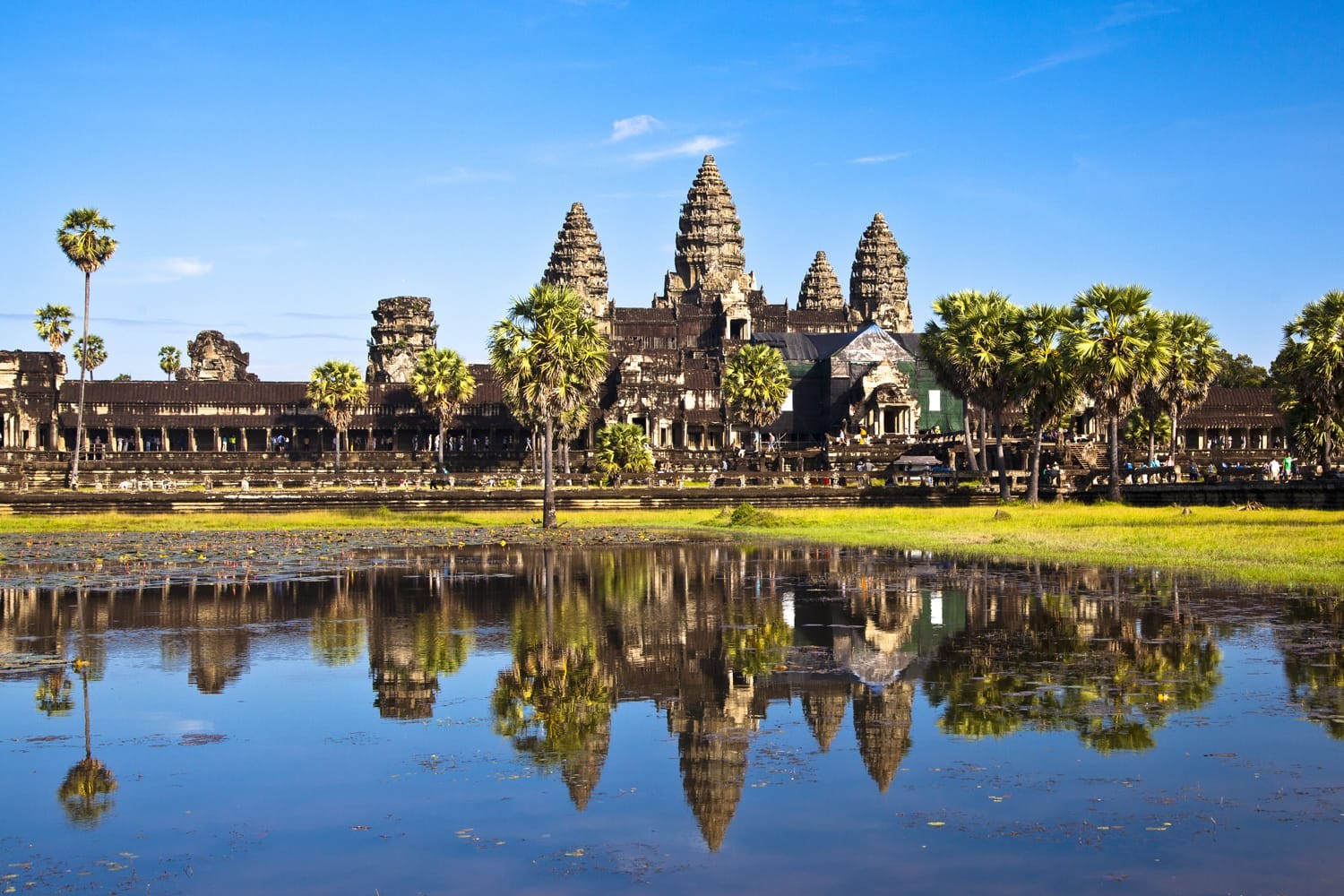
The temple complex is made up of many structures, including the central temple, which is surrounded by four smaller temples, and a moat and wall that encircle the entire site. The temple is known for its intricate carvings and sculptures, depicting scenes from Hindu mythology, as well as everyday life in ancient Cambodia.
Angkor Wat is a popular tourist destination and is visited by thousands of people every year. The best time to visit is early morning, as the sun rises over the temple, or in the late afternoon, as the sun sets, creating a beautiful golden light on the temple's intricate carvings.
Visitors can explore the temple on foot or by bicycle, and it is also possible to take a guided tour of the complex. In recent years, the Cambodian government and UNESCO have been working to preserve and restore the temple complex, so that future generations can continue to appreciate its beauty and cultural significance.
02. Taj Mahal, India:
The Taj Mahal is a white marble mausoleum located in Agra, India. It was commissioned by the Mughal emperor Shah Jahan in memory of his third wife, Mumtaz Mahal, who died during childbirth in 1631. The construction of the Taj Mahal began in 1632 and was completed in 1653.
The Taj Mahal is widely considered one of the most beautiful buildings in the world and is a UNESCO World Heritage Site. It is also considered one of the best examples of Mughal architecture, a blend of Islamic, Persian, Ottoman Turkish and Indian architectural styles.
The main feature of the Taj Mahal is the central domed chamber, which houses the tombs of Mumtaz Mahal and Shah Jahan. The tomb is surrounded by four smaller domes and is situated on a raised platform. The tomb is surrounded by lush gardens, with fountains, walkways, and a reflecting pool.
The Taj Mahal is made of white marble, which is inlaid with precious and semi-precious stones, such as jade, crystal, lapis lazuli, and turquoise, creating intricate geometric patterns and calligraphy. The walls of the tomb are decorated with intricate carvings and inlaid with precious stones.
The Taj Mahal is a major tourist attraction, drawing millions of visitors each year. The best time to visit the Taj Mahal is in the early morning or late afternoon, as the changing light creates different effects on the white marble. Visitors can also take a guided tour of the complex to learn more about its history and architecture.
03. Great Barrier Reef, Australia:
The Great Barrier Reef is one of the world's most iconic natural wonders and a UNESCO World Heritage Site. It is the largest coral reef system in the world, stretching over 2,300 kilometers (1,400 miles) along the northeastern coast of Australia. The reef is home to a diverse array of marine life, including over 1,500 species of fish, 600 species of coral, and thousands of other species of plants and animals.
The Great Barrier Reef is made up of over 2,900 individual reefs and 900 islands, and it is visible from space. It is the world's largest living structure, and it is also the world's largest structure made by living organisms. The reef is a popular destination for tourists, with activities such as snorkeling, scuba diving, and sailing being popular ways to explore the reef.
The Great Barrier Reef is also an important ecosystem, providing habitats for a wide range of marine life, including fish, sharks, rays, dolphins, turtles, and many species of birds. It is also an important economic resource for the region, supporting fishing and tourism industries.
However, in recent years, the reef has been facing several environmental challenges, such as coral bleaching, pollution, and crown-of-thorns starfish outbreak. These problems are mainly caused by human activities like Climate change, water pollution, and overfishing.
The Australian government and various conservation organizations have been working to protect and preserve the reef, through measures such as reducing pollution, protecting endangered species, and promoting sustainable tourism practices.
04. Easter Island, Chile:
Easter Island, also known as Rapa Nui, is a remote island located in the southeast Pacific Ocean, belonging to Chile. It is known for its mysterious ancient statues, called Moai, which are believed to have been carved by the island's indigenous Rapa Nui people. These statues are considered as one of the most impressive examples of prehistoric art in the world.
The island was first settled by Polynesians around the 5th century AD. The Moai statues were carved from volcanic rock between 1250 and 1500 AD, and they range in size from 4 meters (13 feet) to over 20 meters (65 feet) tall. The statues were carved with a distinctive elongated head and strong facial features, and they have become the symbol of the island.
The island is also home to several other archaeological sites, such as ancient village ruins, stone platforms, and petroglyphs, which provide insights into the culture and history of the Rapa Nui people.
Easter Island is a popular destination for tourists who are interested in archaeology, anthropology and culture. Visitors can explore the island's many archaeological sites and learn about the island's history and culture by visiting the island's museums and cultural centers.
The island is also a popular destination for outdoor activities such as hiking, surfing, and diving, as well as for bird watching, as the island is home to many unique bird species, like the Rapa Nui owl and the sooty tern.
Easter Island's isolation and small population, as well as the fragility of the island's ecosystem, have made it a challenge to balance conservation and development. The Chilean government and local organizations have been implementing measures to protect the island's natural and cultural heritage, such as sustainable tourism management and environmental conservation.
05. Petra, Jordan:
Petra is an ancient city located in the southern Jordanian desert, and it is considered one of the most important archaeological sites in the Middle East. It was the capital of the Nabatean Kingdom from around 400 BC to 106 AD, and it is known for its unique rock-cut architecture, including the Treasury, Monastery, and Royal Tombs. Petra is a UNESCO World Heritage Site, and it was also one of the New Seven Wonders of the World.
Petra is believed to have been settled as early as the 4th millennium BCE, but it reached its peak in the 1st century AD, when the Nabateans controlled the trade routes of the region. The Nabateans carved their buildings, tombs and temples into the soft sandstone cliffs, which protected them from the harsh desert climate. The city was also an important religious center, with many temples and shrines dedicated to various gods.
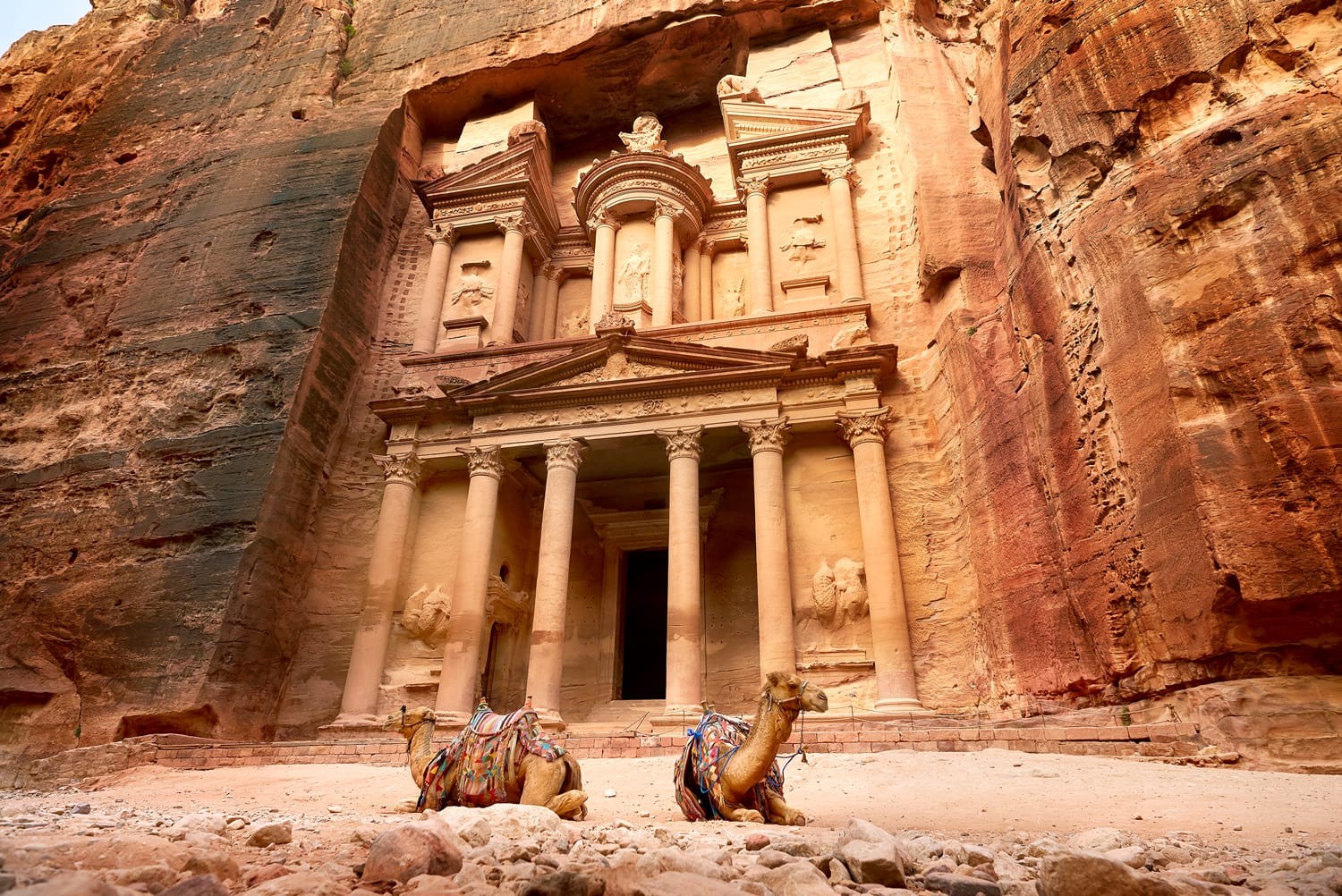
The most famous monument in Petra is the Treasury, also known as Al Khazneh, which is a massive, ornately decorated tomb, carved into the rock face. Other notable monuments include the Monastery, which is similar in design to the Treasury but larger, and the Royal Tombs, which are a series of elaborate tombs cut into the cliffs.
Petra is a popular tourist destination and is visited by thousands of people every year. Visitors can explore the site on foot, horseback, or by camel, and guided tours are also available. The best time to visit Petra is in the early morning or late afternoon, as the changing light creates different effects on the rock-cut architecture.
Petra is also considered a fragile site and the Jordanian government and UNESCO have been working to protect and preserve the site, including limiting the number of daily visitors and promoting sustainable tourism practices.
06. Machu Picchu, Peru:
Machu Picchu is an ancient Incan citadel located in the Andes Mountains of Peru. It is believed to have been built around 1450 AD and was abandoned a century later. The site is now a UNESCO World Heritage Site and one of the most popular tourist destinations in South America. It is known for its stunning architecture, terraced hillsides, and breathtaking views of the surrounding mountains and valleys. Visitors can explore the ruins, climb Huayna Picchu (the mountain behind Machu Picchu), or take a guided tour of the area.
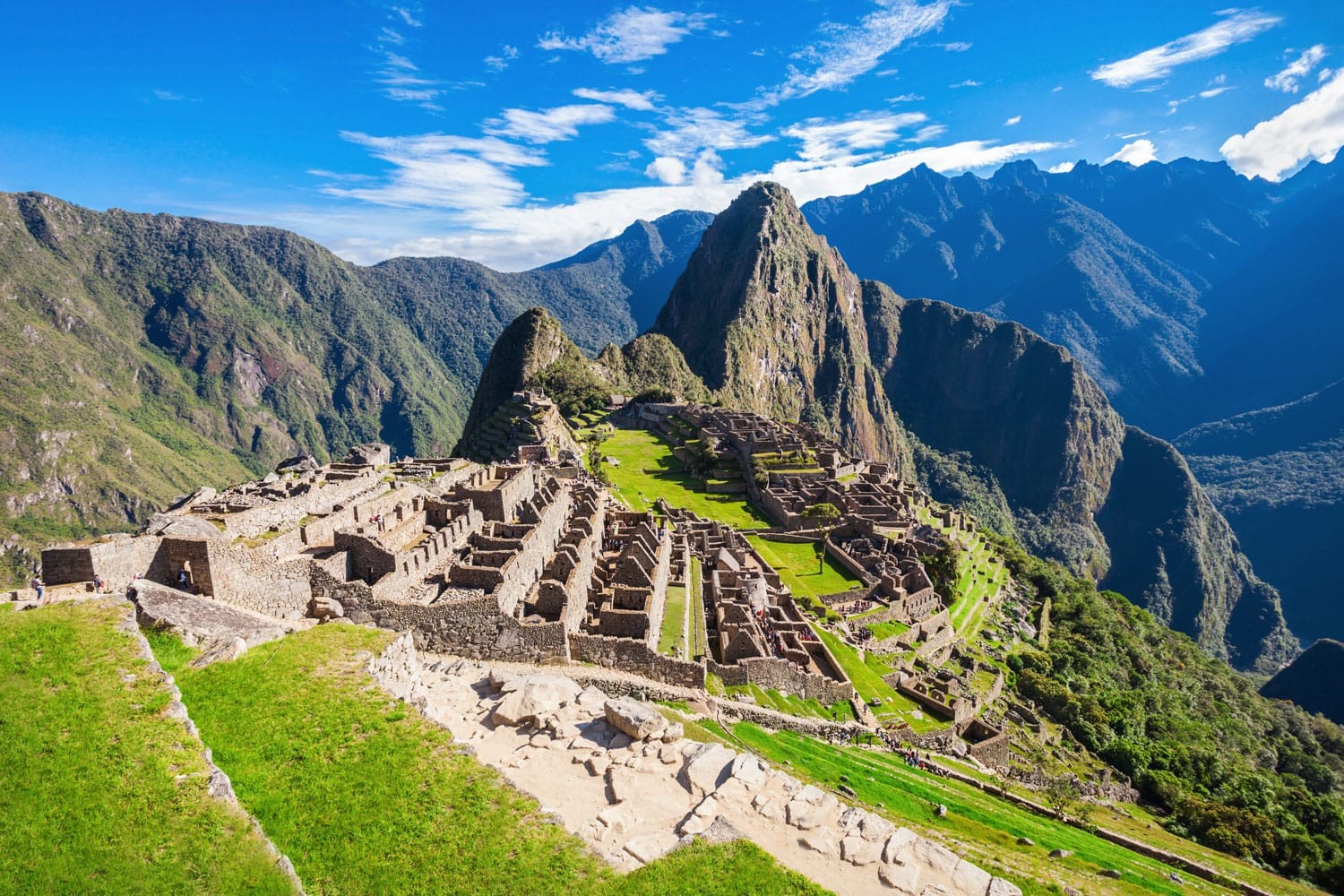
7. Old Havana, Cuba:
Old Havana is a beautiful and historic city located in Cuba. It is the capital of Cuba and is known for its colonial architecture, cobblestone streets, and vibrant culture. Visitors to Old Havana can explore the city's many attractions, including the Plaza de la Catedral, El Morro Castle, and the Museum of the Revolution. There are also plenty of restaurants, bars, and cafes to enjoy in Old Havana. The city is also home to a number of festivals throughout the year, such as Carnival and the International Jazz Festival.
08. Pyramids of Giza, Egypt:
The Pyramids of Giza are a group of ancient Egyptian pyramids located in Giza, on the west bank of the Nile River. The most famous of the three pyramids is the Great Pyramid of Giza, also known as the Pyramid of Khufu, which is the largest and oldest of the three. It was built during the reign of the Pharaoh Khufu in the 26th century BCE and is considered one of the Seven Wonders of the Ancient World. The other two pyramids at Giza are the Pyramid of Khafre and the Pyramid of Menkaure.
All three pyramids were built during the Fourth Dynasty of ancient Egypt. The pyramids were built as tombs for the pharaohs and their consorts and were intended to protect their bodies and provide a place for their spirits to reside in the afterlife.
09. Old City of Jerusalem, Israel:
The Old City of Jerusalem is a walled area within the modern city of Jerusalem. It is home to numerous sites of historical, religious, and cultural significance, including the Temple Mount, the Western Wall, the Church of the Holy Sepulchre, the Dome of the Rock, and the Al-Aqsa Mosque. It is also home to a vibrant and diverse population of Jews, Muslims, and Christians. The Old City is a popular tourist destination, and its narrow, winding streets are filled with shops, restaurants, and other attractions.
10. Great Wall, China:
The Great Wall of China is a series of fortifications built along the historical northern borders of China to protect the Chinese states and empires against the raids and invasions of the various nomadic groups of the Eurasian Steppe. It is one of the world's greatest engineering marvels and the largest man-made structure ever built.
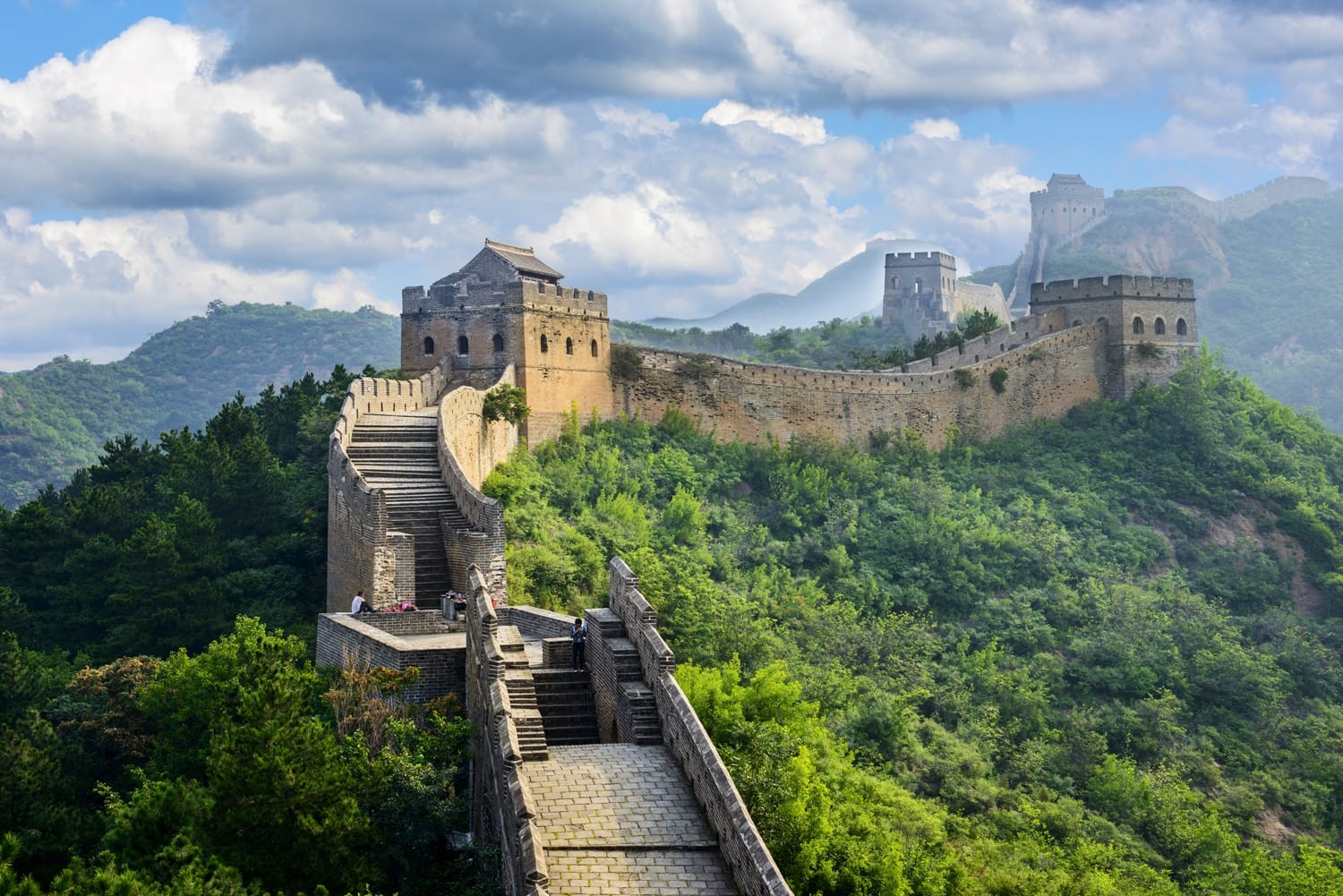
The wall stretches from the east coast of China to the Gobi Desert in the west, and is over 21,000 kilometers (13,000 miles) long. It was built over a period of more than 2,000 years, beginning in the 7th century BC and ending in the 17th century AD. The wall is made of stone, brick, tamped earth, wood, and other materials, and is typically between 6 and 7 meters (20 and 23 feet) high. It is estimated that over a million people were involved in the construction of the Great Wall.
11. Itsukushima Shinto Shrine, Japan:
Itsukushima Shinto Shrine is a Shinto shrine located on the island of Itsukushima (popularly known as Miyajima) in the city of Hatsukaichi in Hiroshima Prefecture, Japan. The shrine complex is listed as a UNESCO World Heritage Site, and the Japanese government has designated several buildings and possessions as National Treasures.
The shrine complex is dedicated to the three daughters of Susano-o no Mikoto, the Shinto god of seas and storms. The shrine is noted for its "floating" torii gate, which appears to be floating on the water during high tide. The shrine is also known for its beautiful views of the Seto Inland Sea and its surrounding mountains.
12. Acropolis, Athens, Greece:
The Acropolis of Athens is an ancient citadel located on a rocky outcrop above the city of Athens. It contains the remains of several ancient buildings of great architectural and historic significance, the most famous being the Parthenon. The Acropolis is a UNESCO World Heritage Site and is one of the most visited sites in Greece. It is also home to the Acropolis Museum, which houses a large collection of artifacts from the site.
13. Cinque Terre, Italy:
Cinque Terre is a stunningly beautiful region of Italy located on the Italian Riviera. It is made up of five small fishing villages, each with its own unique character and charm. The villages are connected by a network of trails and paths, making it a great destination for hikers and nature lovers. The area is known for its stunning views of the Mediterranean Sea, its colorful houses, and its delicious seafood. Visitors can explore the villages, take in the views, and enjoy the local cuisine.
14. Historic Centre of the City of Salzburg, Austria:
The Historic Centre of the City of Salzburg is a UNESCO World Heritage Site located in the city of Salzburg, Austria. It is a well-preserved example of a Baroque city, with its many churches, monasteries, squares, and fortifications. The city is also known for its association with the composer Wolfgang Amadeus Mozart, who was born in Salzburg in 1756. The Historic Centre of the City of Salzburg is a popular tourist destination, with its many attractions, including the Salzburg Cathedral, the Hohensalzburg Fortress, the Mirabell Palace and Gardens, and the Getreidegasse, a narrow street lined with shops and restaurants.
15. Works of Antoni Gaudi, Spain:
Antoni Gaudí was a Spanish architect who is widely regarded as one of the most important figures in the history of architecture. He is best known for his unique and highly individualistic style, which combined elements of Catalan Modernism, Art Nouveau, and Gothic Revival. Gaudí's works are renowned for their organic forms, vibrant colors, and intricate details.
He is most famous for his unfinished masterpiece, the Sagrada Família in Barcelona, which is still under construction today. Gaudí's other works include the Park Güell, Casa Milà, Casa Batlló, and many other iconic buildings in Barcelona. He also designed several churches and other religious buildings throughout Spain. Gaudí's influence on modern architecture is undeniable, and his works continue to inspire architects and designers around the world.
16. Vatican City:
Vatican City is the smallest independent state in the world. It is located within the city of Rome, Italy, and is the spiritual center of the Roman Catholic Church. The Vatican City is ruled by the Pope, who is the head of the Catholic Church. The Vatican City is home to many important religious sites, including St. Peter's Basilica, the Sistine Chapel, and the Vatican Museums. It is also home to the Vatican Library, which houses some of the world's most important religious and historical documents.
17. Rila Monastery, Bulgaria:
Rila Monastery is the largest and most famous Eastern Orthodox monastery in Bulgaria. It is situated in the southwestern Rila Mountains, 117 km south of the capital Sofia. Founded in the 10th century, the Rila Monastery is regarded as one of Bulgaria's most important cultural, historical and architectural monuments. The complex is renowned for its unique combination of Byzantine and Bulgarian culture, as well as for its rich collection of frescoes and icons dating from the 14th–19th centuries. The monastery is also a popular tourist attraction, attracting visitors from all over the world.
18. Giant’s Causeway, UK:
Giant's Causeway is an area of about 40,000 interlocking basalt columns, the result of an ancient volcanic eruption. It is located in County Antrim on the northeast coast of Northern Ireland, about three miles (4.8 km) northeast of the town of Bushmills. It was declared a World Heritage Site by UNESCO in 1986, and a National Nature Reserve in 1987 by the Department of the Environment for Northern Ireland.
The tops of the columns form stepping stones that lead from the cliff foot and disappear under the sea. Most of the columns are hexagonal, although there are also some with four, five, seven or eight sides. The tallest are about 12 metres (39 ft) high, and the solidified lava in the cliffs is 28 metres thick in places.
19. Abu Simbel, Egypt:
20. Chichen Itza, Mexico:
Abu Simbel is an ancient temple complex located in southern Egypt on the western bank of Lake Nasser. It was built by Pharaoh Ramses II in the 13th century BC as a lasting monument to himself and his queen, Nefertari. The complex consists of two massive rock-cut temples, the Great Temple of Ramses II and the Small Temple of Nefertari.
The temples are decorated with scenes of the Pharaoh's military victories and religious rituals. The complex was relocated in the 1960s to avoid the rising waters of Lake Nasser caused by the construction of the Aswan High Dam. Today, Abu Simbel is a popular tourist destination and a UNESCO World Heritage Site.
21. Cultural Landscape of Bali, Indonesia:
The cultural landscape of Bali, Indonesia is a unique blend of Hinduism, Buddhism, and traditional Balinese culture. The landscape is characterized by its lush green rice paddies, terraced hillsides, and beautiful beaches. The Balinese people are known for their vibrant and colorful art, music, and dance.
The island is also home to a variety of temples, shrines, and monuments that reflect the spiritual and cultural heritage of the Balinese people. The landscape is also dotted with traditional villages, where the locals practice their traditional way of life. The culture of Bali is deeply rooted in its spiritual beliefs, and the landscape reflects this.
22. Leshan Giant Buddha, China:
The Leshan Giant Buddha is a 71-meter tall stone statue of Maitreya, the future Buddha, located in the city of Leshan in Sichuan Province, China. It is the largest and tallest stone Buddha statue in the world, and is carved out of a cliff face of Cretaceous red bed sandstones that lies at the confluence of the Minjiang, Dadu and Qingyi rivers. The statue is a popular tourist attraction and has been designated as a UNESCO World Heritage Site since 1996. The Leshan Giant Buddha was built during the Tang Dynasty (618-907) and was completed in 803. It is believed to have been built by a Chinese monk named Haitong, who hoped that the Buddha would calm the turbulent waters that plagued the shipping vessels traveling down the river.
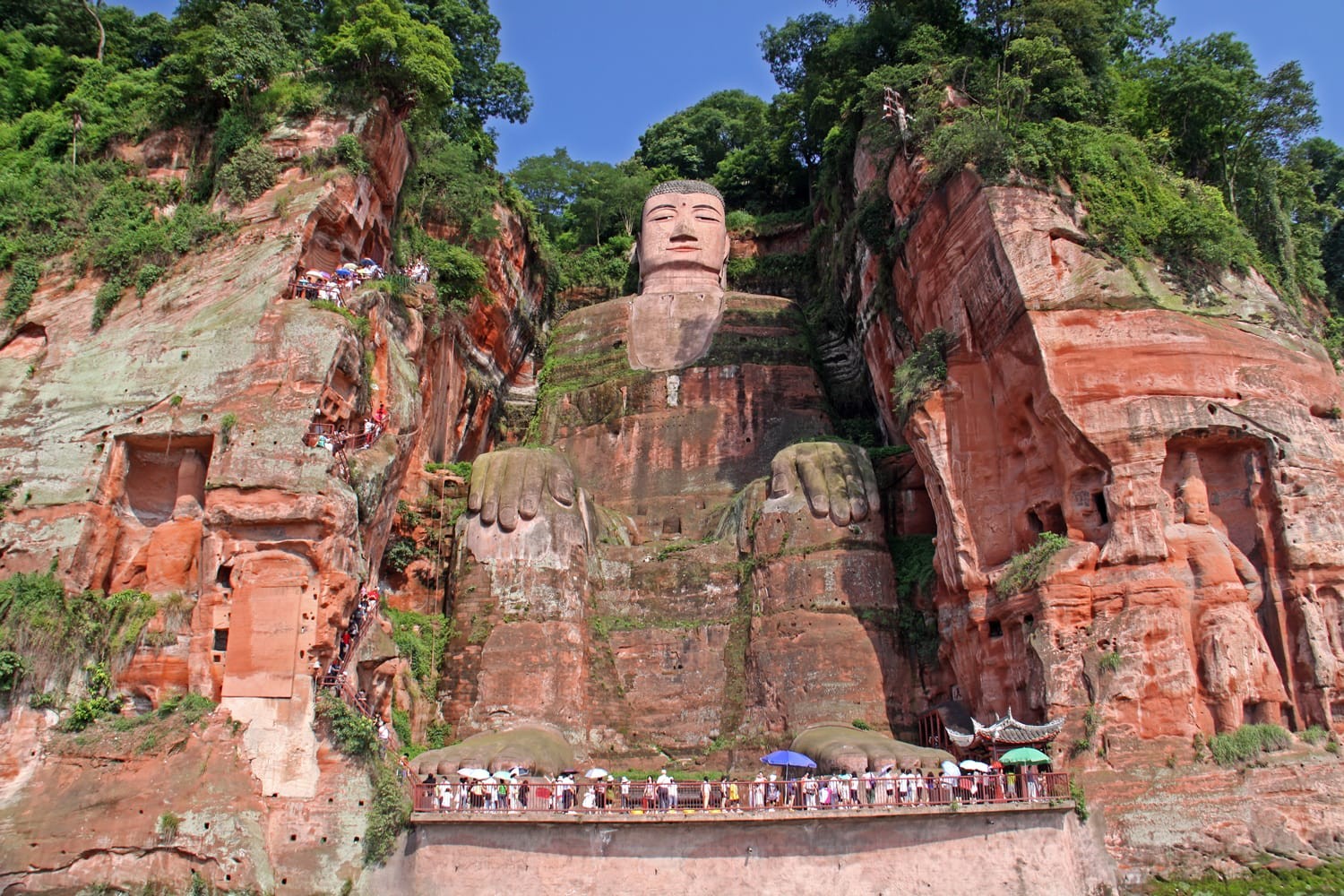
The statue is a representation of the Maitreya Buddha, the future Buddha who will come to earth to restore order and peace. The statue is carved in a seated position, with its hands resting on its knees and its eyes closed in meditation. The statue is surrounded by smaller statues of monks, gods, and animals, all of which were carved into the cliff face.
23. Yellowstone National Park, USA:
Yellowstone National Park is located in the western United States, primarily in the state of Wyoming. It is the world's first national park and is known for its geothermal features, including the world's largest collection of geysers. The park is home to a variety of wildlife, including grizzly bears, wolves, bison, elk, and antelope. It is also home to the Grand Canyon of the Yellowstone, a deep canyon carved by the Yellowstone River. Visitors to the park can enjoy a variety of activities, including hiking, camping, fishing, and wildlife viewing.
24. Cappadocia, Turkey:
Cappadocia is a region in central Turkey known for its unique landscape of eroded rock formations, underground cities, and cave churches. It is a popular tourist destination, offering a variety of activities such as hot air balloon rides, hiking, and horseback riding. The region is also home to many historical sites, including the Göreme Open Air Museum, the Derinkuyu Underground City, and the Uçhisar Castle. Cappadocia is also known for its traditional Turkish cuisine, such as kebabs, pide, and baklava.
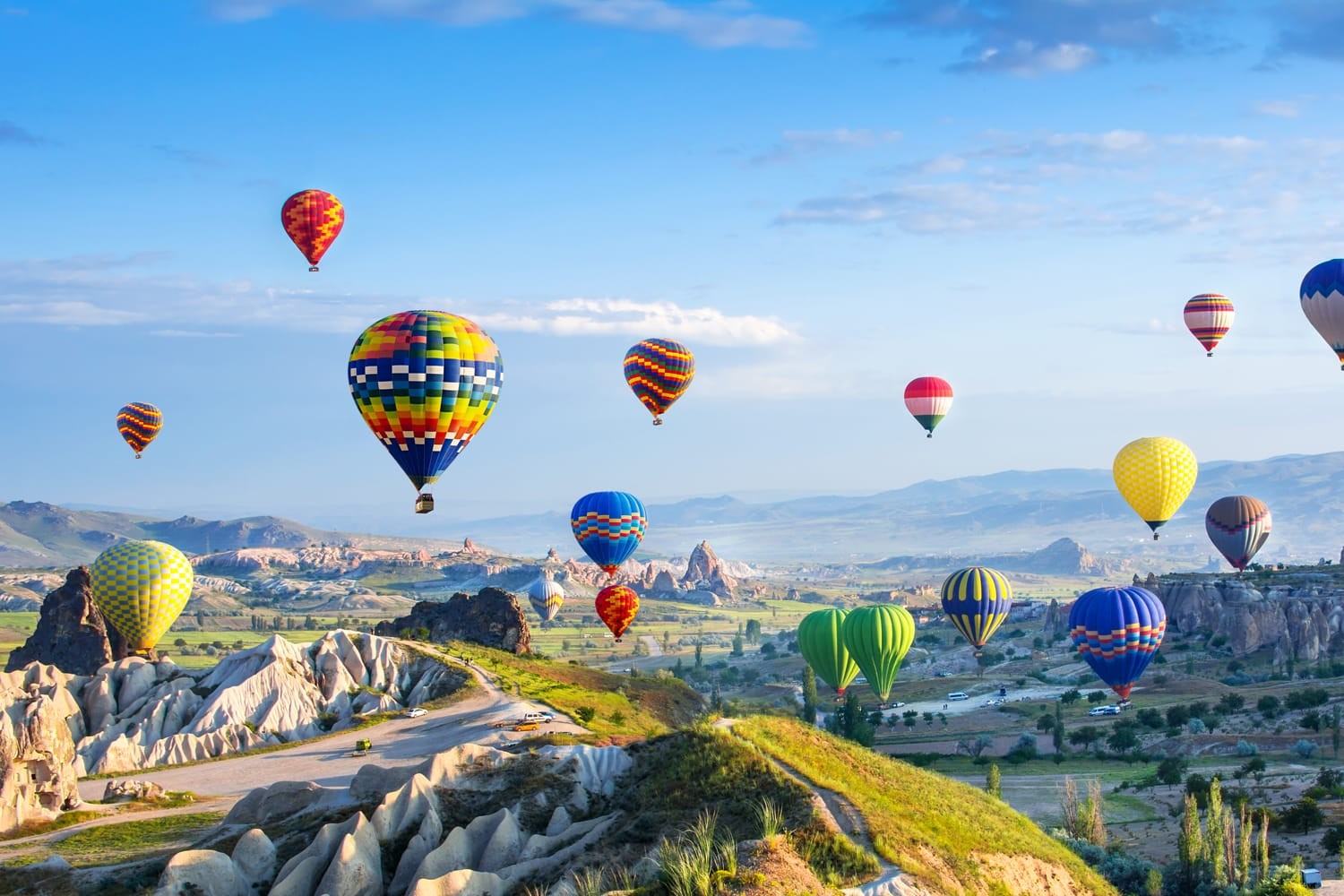
25. Galapagos Islands, Ecuador:
The Galapagos Islands are an archipelago of volcanic islands located in the Pacific Ocean off the coast of Ecuador. The islands are renowned for their unique and diverse wildlife, which inspired Charles Darwin's theory of evolution. The islands are home to a variety of species, including giant tortoises, marine iguanas, sea lions, and a variety of birds. The islands are also a popular destination for scuba diving, snorkeling, and other water activities.
26. Los Glaciares National Park, Argentina:
Glaciers National Park, located in the Argentine province of Santa Cruz, is a UNESCO World Heritage Site. It is home to some of the most spectacular glaciers in the world, including the Perito Moreno Glacier, one of the few advancing glaciers in the world. The park is also home to a variety of wildlife, including guanacos, condors, and flamingos. Visitors can explore the park on foot, by boat, or by car. Popular activities include trekking, ice climbing, and kayaking. The park also offers a variety of educational programs and guided tours.
27. Venice, Italy:
Venice, Italy is a beautiful and romantic city located in the Veneto region of northern Italy. It is known for its canals, gondolas, and stunning architecture. Venice is a popular tourist destination, with many attractions such as the Grand Canal, St. Mark's Square, the Rialto Bridge, and the Doge's Palace. There are also many museums, churches, and other historical sites to explore. Venice is also known for its delicious cuisine, with seafood being a specialty.
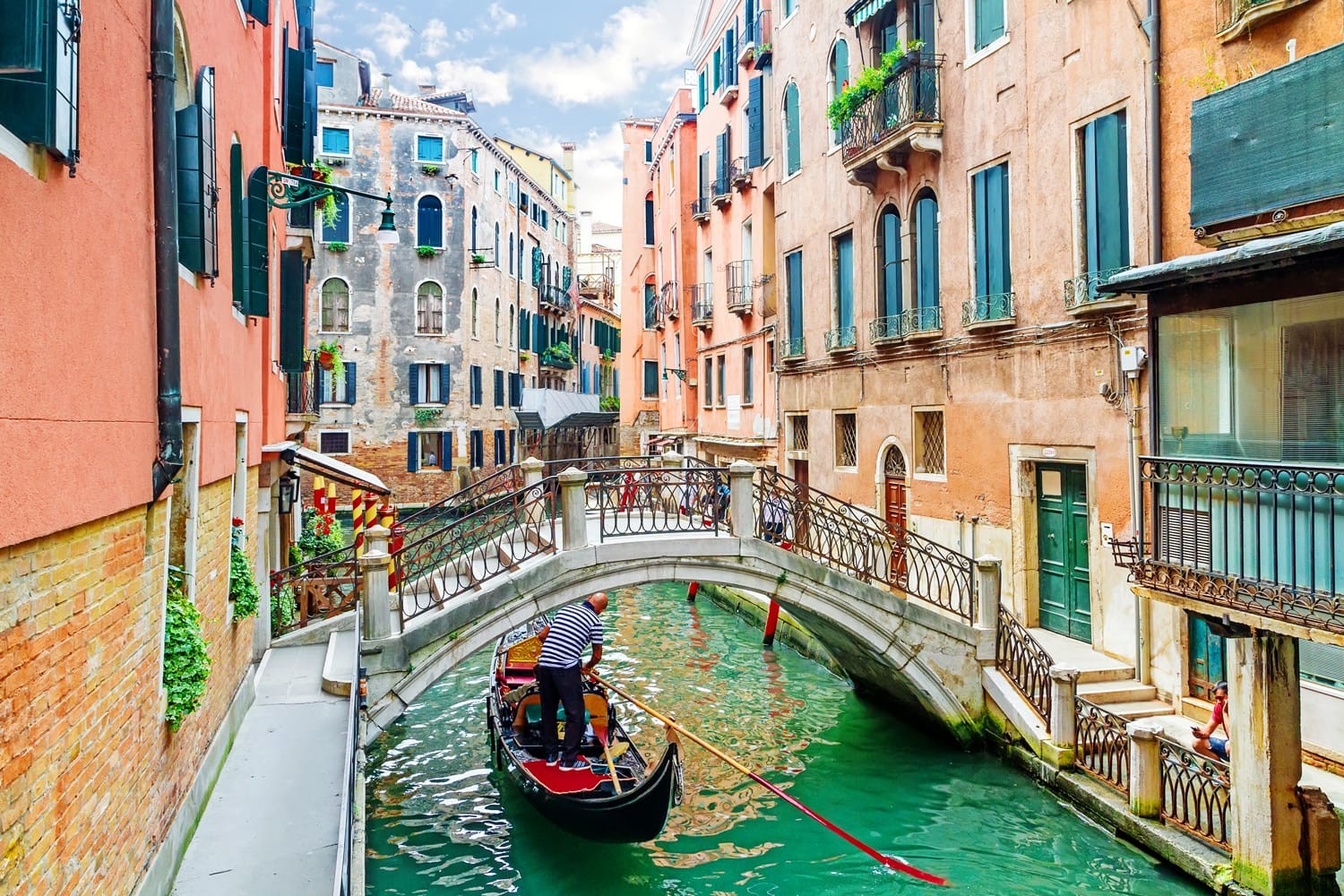
28. Plitvice Lakes National Park, Croatia:
Plitvice Lakes National Park is a stunning natural wonder located in Croatia. It is one of the oldest and largest national parks in the country, and is a UNESCO World Heritage Site. The park is known for its 16 terraced lakes, which are connected by a series of cascading waterfalls. The lakes are surrounded by lush forests, and the park is home to a variety of wildlife, including bears, wolves, and rare bird species. Visitors can explore the park on foot, by boat, or by taking a cable car to the top of the highest waterfall. There are also several restaurants and hotels located nearby, making it a great destination for a day trip or a longer stay.
29. Ha Long Bay, Vietnam:
Ha Long Bay is a stunning natural wonder located in the Gulf of Tonkin, in northern Vietnam. It is a UNESCO World Heritage Site and is known for its emerald waters and thousands of towering limestone islands topped with rainforests. The bay is a popular tourist destination, offering visitors a chance to explore its many caves, kayak around its islands, and take boat tours to view the stunning scenery. Ha Long Bay is also home to a variety of wildlife, including monkeys, lizards, and birds.
30. Iguazu National Park, Brazil/Argentina:
Iguazu National Park is a national park located in the Brazilian state of Paraná, near the border with Argentina. It is home to the spectacular Iguazu Falls, one of the world’s largest waterfalls. The park is also home to a wide variety of wildlife, including jaguars, ocelots, toucans, and howler monkeys. The park is a popular tourist destination, with visitors coming from all over the world to experience the beauty of the falls and the surrounding rainforest.
31. Hampi, India:
Hampi is a village in northern Karnataka, India. It is located within the ruins of the city of Vijayanagara, the former capital of the Vijayanagara Empire. Hampi is a popular tourist destination, known for its historical monuments, temples, and beautiful landscapes. The area is also home to many ancient monuments, including the Virupaksha Temple, the Vittala Temple complex, the Hazara Rama Temple, and the Queen's Bath. Other attractions include the Elephant Stables, the Lotus Mahal, and the Stone Chariot. The area is also known for its vibrant markets, where visitors can find a variety of local handicrafts and souvenirs.
32. Bagan, Myanmar:
Bagan is an ancient city located in the Mandalay Region of Myanmar. It is one of the most important archaeological sites in Southeast Asia and is home to the largest and most diverse collection of Buddhist monuments, temples, and pagodas in the world. The city was the capital of the Pagan Kingdom from the 9th to the 13th centuries and is now a UNESCO World Heritage Site.
Visitors to Bagan can explore the many temples and pagodas, take a hot air balloon ride over the city, and visit the nearby villages to learn about the local culture and traditions. There are also a number of markets and restaurants in the area, as well as a number of hotels and resorts.
33. Mont Saint Michel, France:
Mont Saint Michel is a rocky tidal island located in Normandy, France. It is home to a medieval Benedictine abbey, which is a popular tourist destination. The abbey is perched atop a rocky outcrop and surrounded by the fast-flowing waters of the Couesnon River.
The abbey is a UNESCO World Heritage Site and is one of the most visited sites in France. The island is accessible by a causeway and visitors can explore the abbey, the village, and the surrounding bay. The island is also home to a variety of wildlife, including seabirds, seals, and other marine life.
34. Serengeti National Park, Tanzania:
Serengeti National Park is a vast expanse of savannah grasslands in northern Tanzania. It is home to the largest concentration of wildlife in the world, including the Big Five (lion, leopard, elephant, buffalo, and rhino). The park is also known for its annual wildebeest migration, which sees millions of animals traverse the plains in search of fresh grazing grounds.
The park is also home to a variety of other animals, including cheetahs, hyenas, giraffes, zebras, and gazelles. Visitors to the park can take part in game drives, hot air balloon safaris, and guided walking tours.
35. Archaeological Site (Madâin Sâlih), Saudi Arabia:
Madâin Sâlih is an archaeological site located in the Al-Ula region of Saudi Arabia. It is the largest and most important site of the ancient civilization of the Nabataeans, who inhabited the area from the 1st century BC to the 1st century AD. The site contains a number of well-preserved tombs, temples, and other structures, as well as a large number of inscriptions in various languages. The site was declared a UNESCO World Heritage Site in 2008.
36. Pergamon, Turkey:
Pergamon is an ancient city located in modern-day Turkey. It was once the capital of the Attalid dynasty, a Hellenistic kingdom that ruled over much of the Aegean region. The city is known for its impressive ruins, which include the Temple of Trajan, the Library of Pergamon, and the Altar of Zeus. The city is also home to the Pergamon Museum, which houses many of the artifacts found at the site.
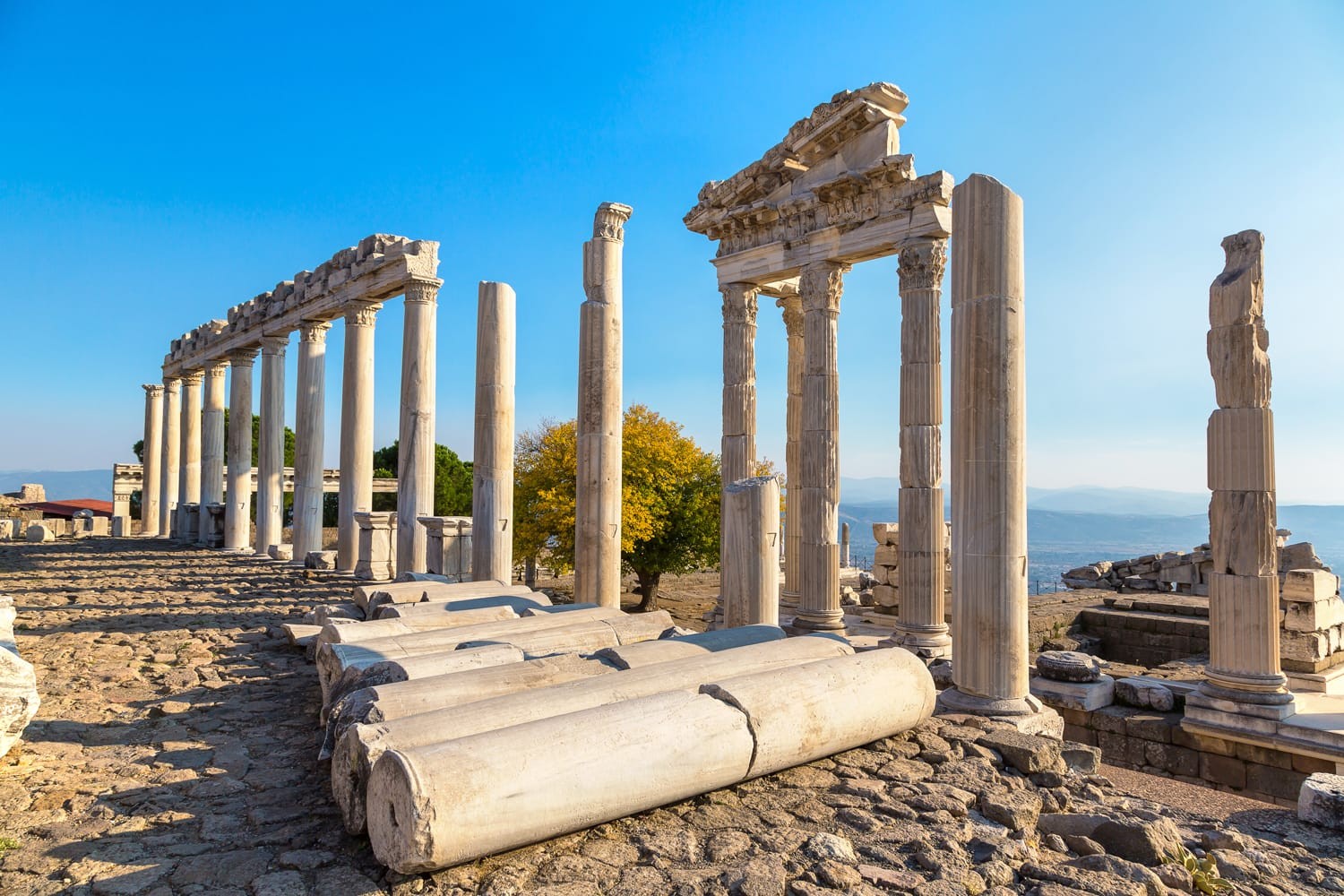
37. Rani-ki-Vav, India:
Rani-ki-Vav is a stepwell located in the town of Patan in Gujarat, India. It was built as a memorial to an 11th-century queen. The stepwell is located on the banks of the Saraswati River and is one of the most famous and elaborate stepwells in India. It is a unique form of subterranean water resource and storage system. The stepwell is divided into seven levels of stairs with sculptural panels of high artistic quality.
The walls are carved with more than 500 principle sculptures and over a thousand minor ones combining religious, mythological and secular imagery, often referencing literary works. The stepwell is now a UNESCO World Heritage Site and is considered one of the finest examples of Indian sculpture.
38. Grand Canyon National Park, USA:
Grand Canyon National Park is located in Arizona, USA. It is one of the most visited national parks in the United States. The park is known for its spectacular views of the Grand Canyon, a steep-sided gorge carved by the Colorado River. The park covers 1,217,403 acres of land and is home to a variety of wildlife, including bighorn sheep, elk, mule deer, and mountain lions. Visitors can explore the canyon by hiking, rafting, and taking scenic drives. The park also offers a variety of educational programs, including ranger-led hikes and talks.
39. Dolomites, Italy:
The Dolomites are a mountain range located in northeastern Italy. They are part of the Southern Limestone Alps and extend from the River Adige in the west to the Piave Valley in the east. The Dolomites are renowned for their dramatic, rugged beauty and are a popular destination for hikers, climbers, and skiers. The area is also home to a variety of wildlife, including chamois, ibex, marmots, and golden eagles. The Dolomites are also known for their unique geological formations, such as the Three Peaks of Lavaredo and the Sella Massif.
40. Schönbrunn Palace and Gardens, Austria:
Schönbrunn Palace and Gardens is a World Heritage Site located in Vienna, Austria. It is one of the most important cultural monuments in the country and is a popular tourist attraction. The palace was built in the 17th century and is a Baroque masterpiece. The gardens are a sprawling complex of manicured lawns, fountains, and sculptures.
Visitors can explore the palace and its grounds, including the world-famous Gloriette, a hilltop terrace with stunning views of Vienna. The palace also houses a zoo, a maze, and a maze garden. The gardens are open year-round and offer a variety of activities, including guided tours, concerts, and special events.
41. Cesky Krumlov, Czech Republic:
Cesky Krumlov is a small town in the Czech Republic located in the South Bohemian Region. It is a popular tourist destination due to its picturesque setting on the Vltava River and its well-preserved medieval architecture. The town is home to a number of attractions, including the Cesky Krumlov Castle, the Baroque-style St. Vitus Church, and the Egon Schiele Art Centrum. Visitors can also explore the town's many cobblestone streets, take a boat ride on the river, or enjoy a variety of outdoor activities such as hiking, biking, and fishing.
42. Forbidden City, China:
The Forbidden City is a palace complex in central Beijing, China. It served as the home of emperors and their households as well as the ceremonial and political center of Chinese government for almost 500 years. The Forbidden City was declared a World Heritage Site in 1987 and is listed by UNESCO as the largest collection of preserved ancient wooden structures in the world.
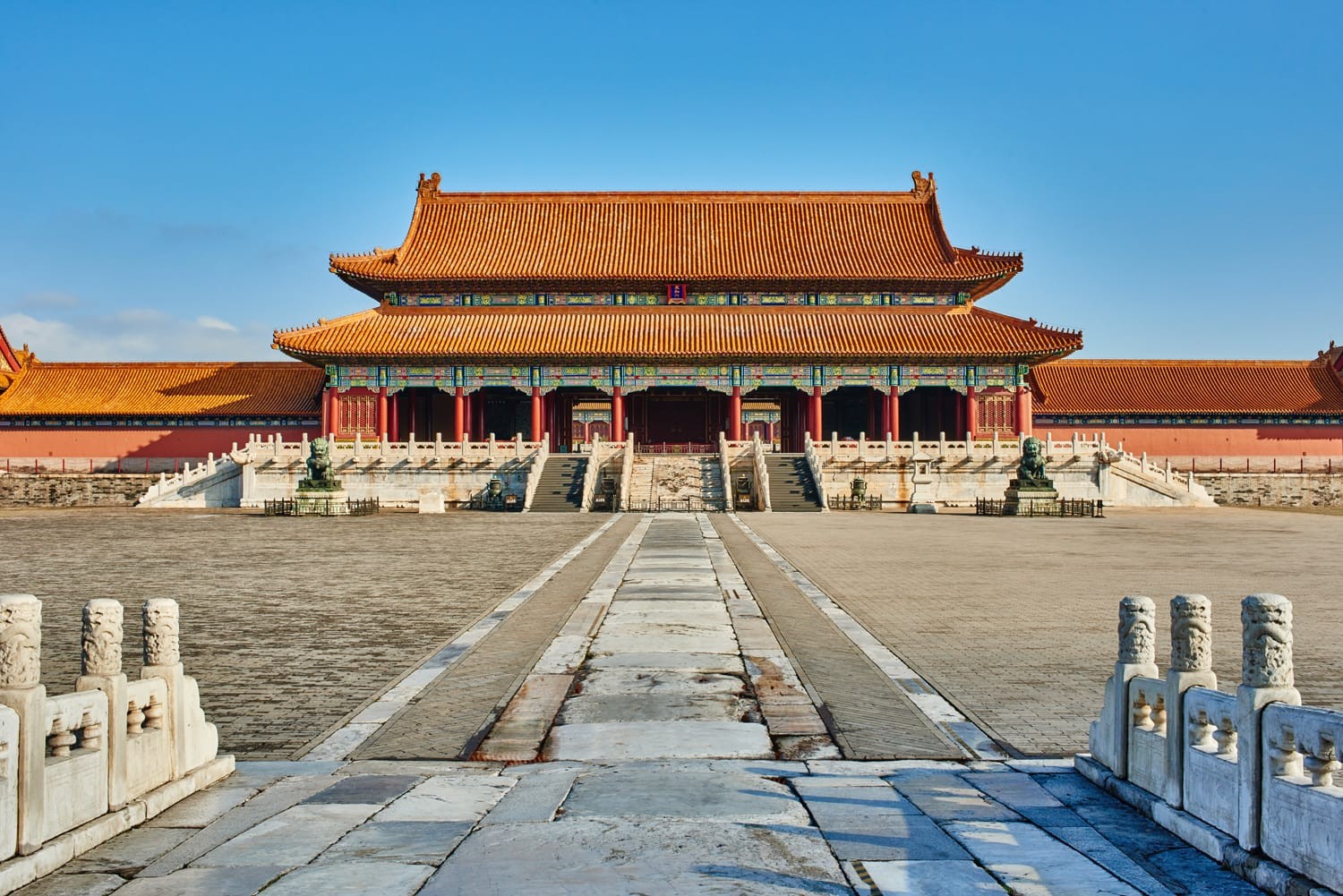
The Forbidden City is composed of 980 buildings and covers 72 hectares (180 acres). It is surrounded by a 6-meter-high (20 ft) wall and a moat. The wall has a gate on each side. The most iconic gate is the Meridian Gate, which is the southern gate of the Forbidden City and the main entrance to the palace. Inside the Forbidden City, there are many important structures, including the Hall of Supreme Harmony, the Hall of Central Harmony, the Hall of Preserving Harmony, the Imperial Garden, and the Palace of Heavenly Purity.
43. Uluru-Kata Tjuta National Park, Australia:
Uluru-Kata Tjuta National Park is located in the Northern Territory of Australia. It is home to two of Australia's most iconic natural landmarks, Uluru (Ayers Rock) and Kata Tjuta (The Olgas). The park is home to a wide variety of wildlife, including kangaroos, dingoes, emus, and many species of birds. The park is also home to a number of Aboriginal cultural sites, including rock art, ceremonial sites, and sacred sites. Visitors to the park can take part in a variety of activities, including guided walks, camel rides, and star gazing.
44. Tikal National Park, Guatemala:
Tikal National Park is a UNESCO World Heritage Site located in the Petén region of northern Guatemala. It is one of the largest and most important archaeological sites of the Mayan civilization, and is home to some of the most impressive Mayan ruins in the world. The park covers an area of 575 square kilometers and is home to a variety of wildlife, including jaguars, howler monkeys, toucans, and parrots. Visitors to the park can explore the ruins, take guided tours, and learn about the history and culture of the Mayan people.
45. Statue of Liberty, USA:
The Statue of Liberty is a colossal neoclassical sculpture on Liberty Island in New York Harbor in New York City, in the United States. The copper statue, a gift from the people of France to the people of the United States, was designed by French sculptor Frédéric Auguste Bartholdi and its metal framework was built by Gustave Eiffel. The statue was dedicated on October 28, 1886, and was a welcoming sight to immigrants arriving from abroad.
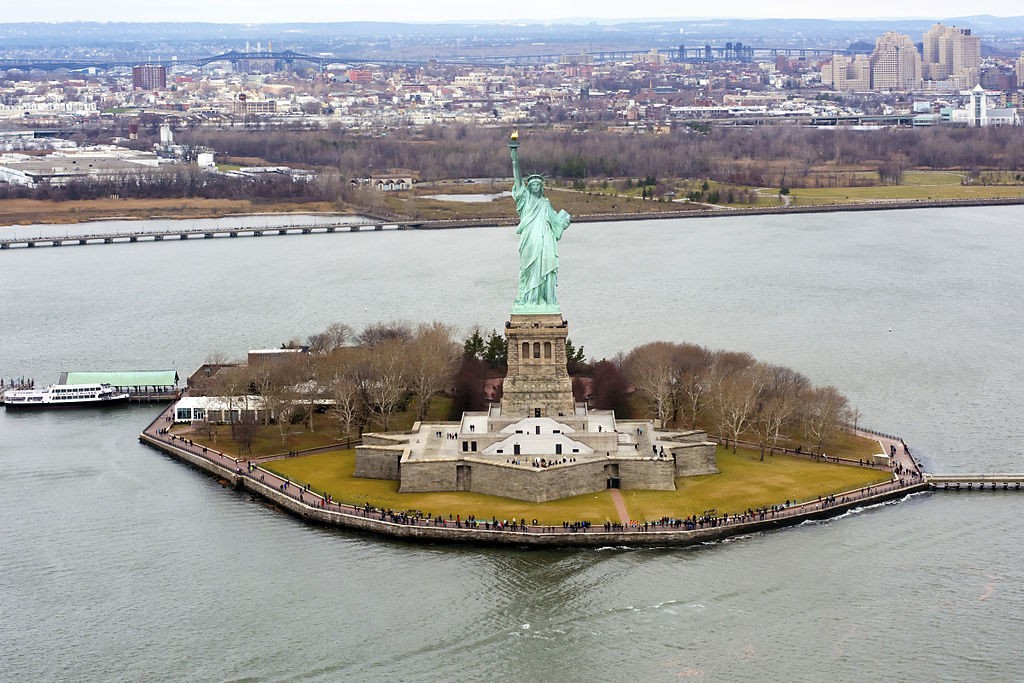
The Statue of Liberty is a symbol of freedom and democracy, and has become an iconic representation of the United States. The statue stands 305 feet (93 meters) tall, and the foundation of the pedestal it stands on is 154 feet (47 meters) tall. The statue's torch is a symbol of enlightenment, and the seven spikes on the crown represent the seven seas and seven continents of the world. The tablet in the statue's left hand is inscribed with the date of the American Declaration of Independence, July 4, 1776.
46. Canadian Rocky Mountain Parks, Canada:
The Canadian Rocky Mountain Parks are a group of four national parks located in the Canadian Rockies of Alberta and British Columbia. They are Banff National Park, Jasper National Park, Kootenay National Park, and Yoho National Park. The parks are home to a wide variety of wildlife, including grizzly bears, wolves, elk, bighorn sheep, mountain goats, and more. The parks also feature stunning mountain scenery, including glaciers, waterfalls, and hot springs. There are numerous hiking trails, camping sites, and other recreational activities available in the parks.
47. Hierapolis-Pamukkale, Turkey:
Hierapolis-Pamukkale is a UNESCO World Heritage Site located in southwestern Turkey. It is known for its natural hot springs, travertine terraces, and ancient ruins. The site is home to the ruins of the ancient city of Hierapolis, which was founded in the 2nd century BC by the King of Pergamon. The city was destroyed by an earthquake in the 6th century AD and was later rebuilt by the Byzantines. The site also includes the ruins of the Temple of Apollo, the Necropolis, and the Roman Baths. Visitors can explore the ruins, take a dip in the hot springs, and admire the stunning travertine terraces.
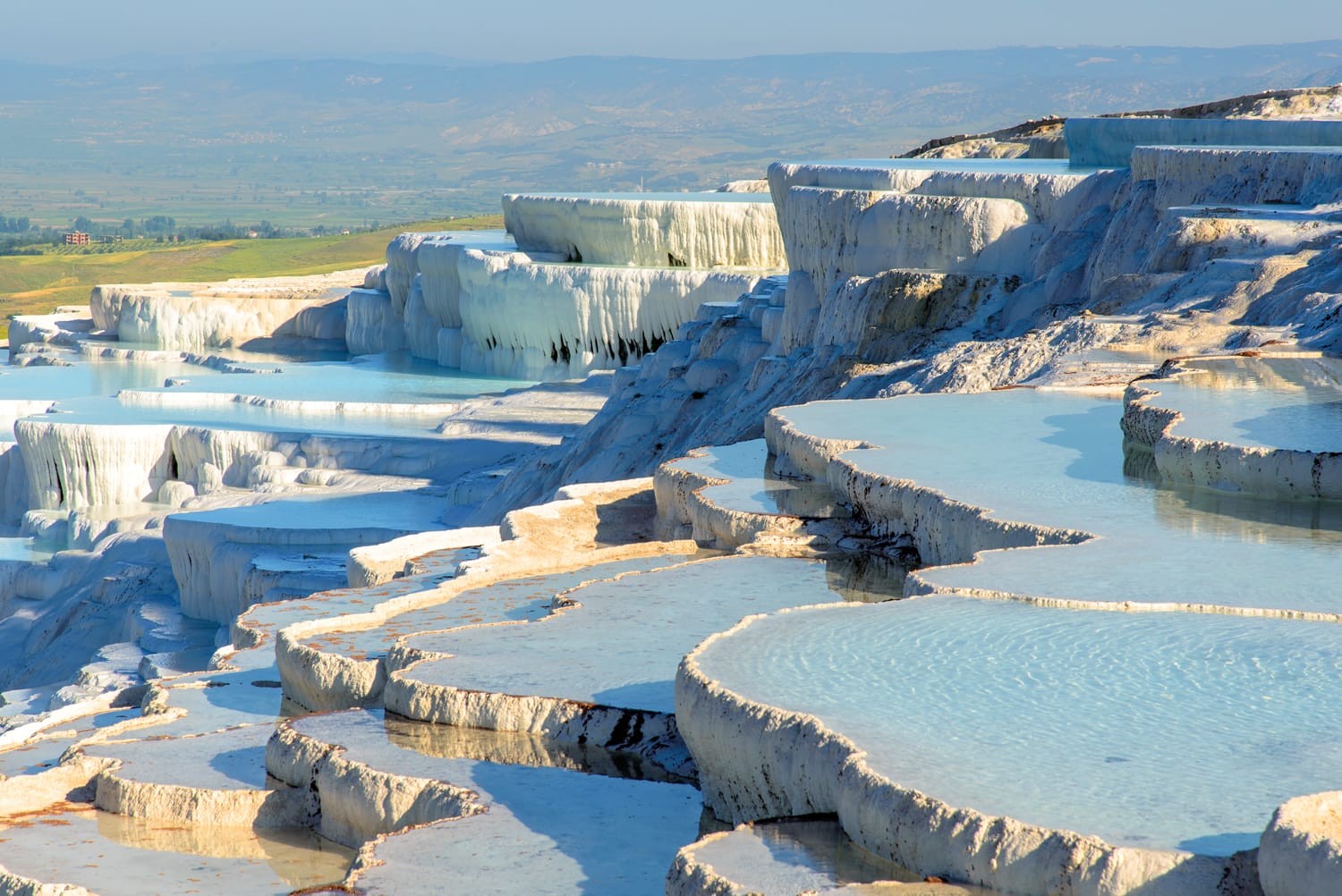
48. Bam, Iran:
Bam is a city in the Kerman Province of Iran. It is located in the southeastern part of the country, near the border with Pakistan. The city is known for its ancient citadel, which was destroyed in an earthquake in 2003. The city is home to a number of historical sites, including the Bam Citadel, the Arg-e Bam, and the Bam Cultural Landscape. The city is also home to a number of museums, including the Bam Museum of Archaeology and the Bam Museum of Natural History.
49. Ayutthaya Historical Park, Thailand:
Ayutthaya Historical Park is a vast archaeological site in Thailand that contains the ruins of the former capital of the Ayutthaya Kingdom. The park is located in the Ayutthaya province, about 80 kilometers north of Bangkok. It covers an area of over 2,000 acres and contains more than 400 ruins, including palaces, temples, monasteries, and statues.
The park is a UNESCO World Heritage Site and is one of the most popular tourist attractions in Thailand. Visitors can explore the ruins, learn about the history of the kingdom, and take in the beautiful scenery.
50. Historic Centre of Rome, Italy:
The Historic Centre of Rome is a UNESCO World Heritage Site located in the heart of the Italian capital. It is home to some of the world’s most iconic monuments, including the Colosseum, the Pantheon, the Trevi Fountain, and the Spanish Steps. The area is also home to numerous churches, palaces, and other important sites, such as the Roman Forum, the Capitoline Hill, and the Catacombs of St. Callixtus. The Historic Centre of Rome is a must-see for any visitor to the city, offering a glimpse into the city’s rich history and culture.
51. St. Kilda, Scotland:
St. Kilda is an archipelago located in the North Atlantic Ocean, about 65 miles west of the Outer Hebrides of Scotland. It is the most remote part of the British Isles and is home to the world’s largest colony of seabirds. The islands are home to a variety of wildlife, including puffins, gannets, and fulmars. The islands are also home to a unique culture, with a long history of fishing and subsistence farming. The islands are now a UNESCO World Heritage Site and are managed by the National Trust for Scotland.
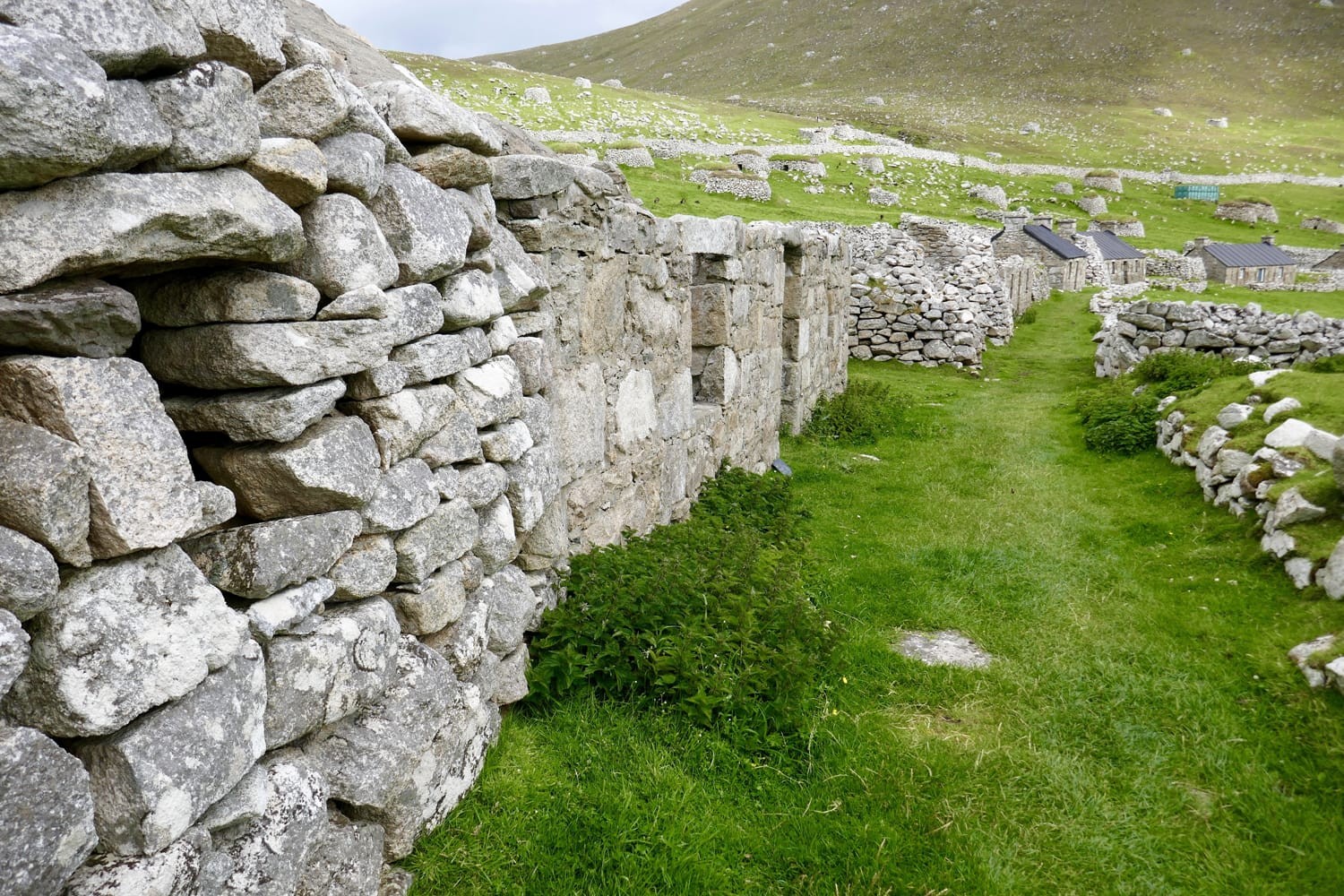
52. La Grand-Place, Belgium:
La Grand-Place is the central square of Brussels, Belgium. It is a UNESCO World Heritage Site and one of the most visited tourist attractions in the city. The square is surrounded by guildhalls, the Town Hall, and the King's House. It is also home to the famous Manneken Pis statue. The square is a popular gathering place for locals and tourists alike, and is the site of many festivals and events throughout the year.
53. Tongariro National Park, New Zealand:
Tongariro National Park is located in the central North Island of New Zealand. It is the oldest national park in the country, established in 1887. The park is known for its three active volcanoes, Mount Tongariro, Mount Ngauruhoe, and Mount Ruapehu, as well as its diverse landscape of alpine meadows, forests, and lakes. The park is also home to the famous Tongariro Alpine Crossing, a 19.4 km one-day hike that takes hikers through some of the most stunning scenery in the park. The park is also a popular destination for skiing, snowboarding, and mountain biking.
54. Socotra Archipelago, Yemen:
The Socotra Archipelago is an archipelago located off the coast of Yemen in the Indian Ocean. It consists of four islands, the largest of which is Socotra. The archipelago is home to a unique and diverse range of flora and fauna, and is considered one of the most biodiverse places on Earth. The islands are also home to a variety of traditional cultures, including the Soqotri people. The archipelago is a UNESCO World Heritage Site and is protected by the Yemeni government.
55. Wulingyuan, China:
Wulingyuan is a scenic and historic area located in the Hunan Province of China. It is most famous for its stunning sandstone pillars, which are the result of millions of years of erosion. The area is also home to a variety of wildlife, including the endangered Chinese giant salamander. Wulingyuan is a popular tourist destination, and is home to the Zhangjiajie National Forest Park, which is a UNESCO World Heritage Site. Visitors can explore the area by hiking, taking cable cars, or taking a boat ride on the nearby Suoxi Valley River.
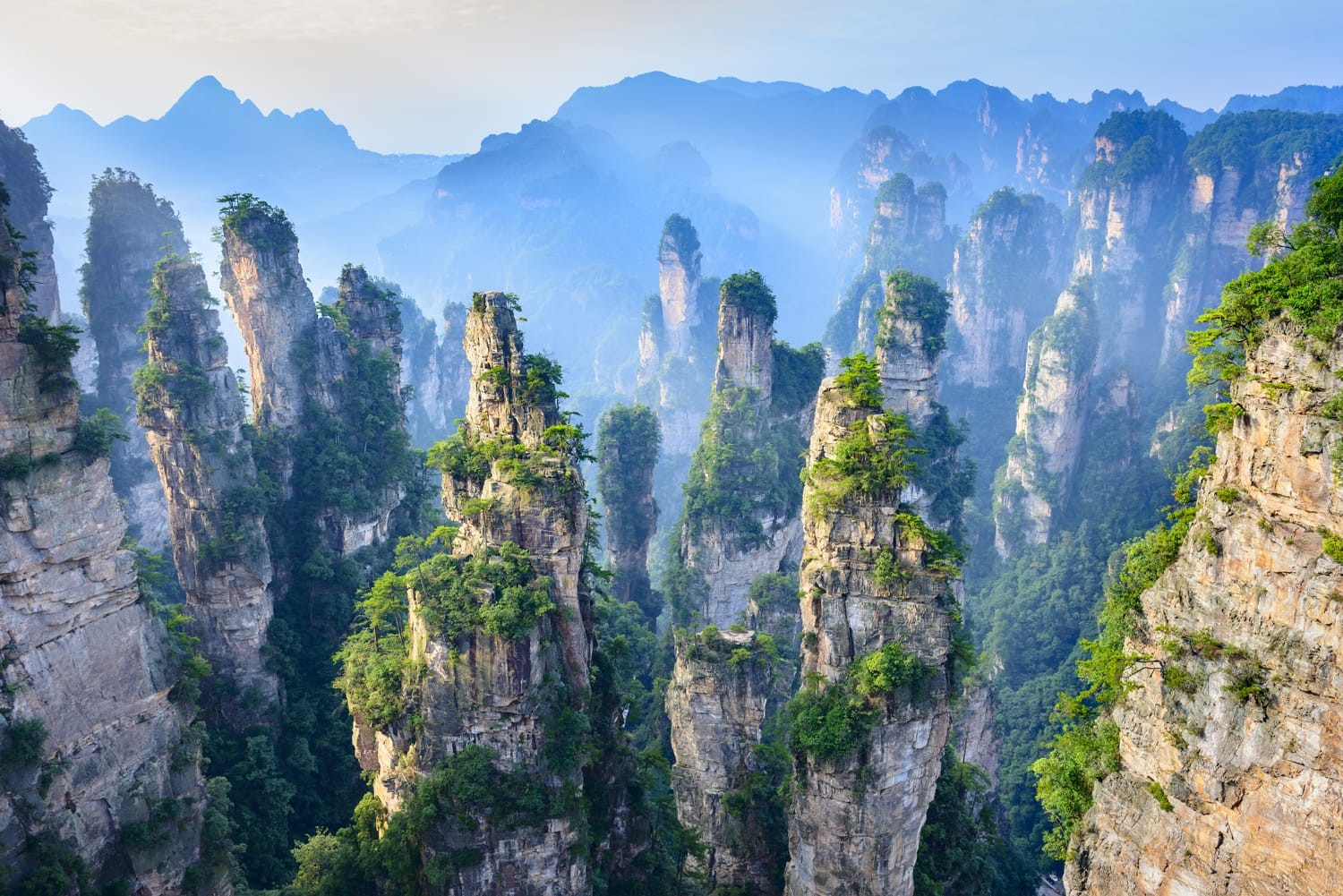
56. Historic Centre of Florence, Italy:
The Historic Centre of Florence, Italy is a UNESCO World Heritage Site located in the heart of the city. It is home to some of the world’s most iconic Renaissance art and architecture, including the Duomo, the Ponte Vecchio, and the Uffizi Gallery. The Historic Centre of Florence is a living museum of the city’s past, with its winding streets, cobblestone alleys, and ancient buildings. It is a must-see for any visitor to Florence, and a great way to experience the city’s rich history and culture.
57. Yosemite National Park, USA:
Yosemite National Park is located in the Sierra Nevada mountains of California, USA. It is one of the most popular national parks in the United States, and is known for its spectacular granite cliffs, waterfalls, giant sequoia trees, and diverse wildlife. Yosemite is home to many activities, including hiking, camping, rock climbing, and horseback riding. The park also offers a variety of educational programs, such as ranger-led hikes and talks, and special events.
58. Old City of Dubrovnik, Croatia:
The Old City of Dubrovnik is a UNESCO World Heritage Site located in Croatia. It is a walled city on the Adriatic Sea coast and is one of the most popular tourist destinations in the country. The city is known for its stunning architecture, cobblestone streets, and stunning views of the Adriatic Sea. It is also home to many historical sites, including the Dubrovnik Cathedral, the Franciscan Monastery, and the Rector's Palace. Visitors can explore the city's many attractions, including its many churches, museums, and galleries. The city is also home to a vibrant nightlife, with many bars, restaurants, and clubs.
59. Timbuktu, Mali:
Timbuktu is a city in Mali, located on the southern edge of the Sahara Desert. It is an important cultural and religious center, and is known for its ancient mosques and libraries. It is also a major trading center, and is home to a large population of Tuareg people. The city is a UNESCO World Heritage Site, and is a popular tourist destination.
60. Old Town of Ghadames, Libya:
The Old Town of Ghadames is a UNESCO World Heritage Site located in the Nalut District of Libya. It is an ancient oasis city, known as the "Pearl of the Desert", and is one of the oldest pre-Saharan cities in the world. The Old Town of Ghadames is a well-preserved example of traditional Berber architecture, with narrow, winding streets and whitewashed buildings. The city is surrounded by a wall and is divided into four distinct quarters, each with its own mosque and public square. The Old Town of Ghadames is a popular tourist destination, offering visitors a unique insight into the culture and history of the region.
61. Carlsbad Caverns National Park, USA:
Carlsbad Caverns National Park is located in the Guadalupe Mountains of southeastern New Mexico. The park is home to over 119 known caves, the most famous of which is Carlsbad Cavern. The park is known for its unique geological formations, including stalactites, stalagmites, and other cave decorations. Visitors can explore the caves on their own or take a guided tour. The park also offers a variety of outdoor activities, including hiking, camping, and bird watching.
62. China Danxia, China:
China Danxia is a unique type of landform found in the southeastern and southwestern parts of China. It is characterized by a series of steep cliffs, deep valleys, and colorful rock formations. The landforms are formed by the erosion of red sandstone and other sedimentary rocks, which have been uplifted by tectonic activity. The area is known for its unique landscapes, which are often compared to a "miniature Grand Canyon". The area is also home to a variety of rare plants and animals, making it a popular destination for tourists.
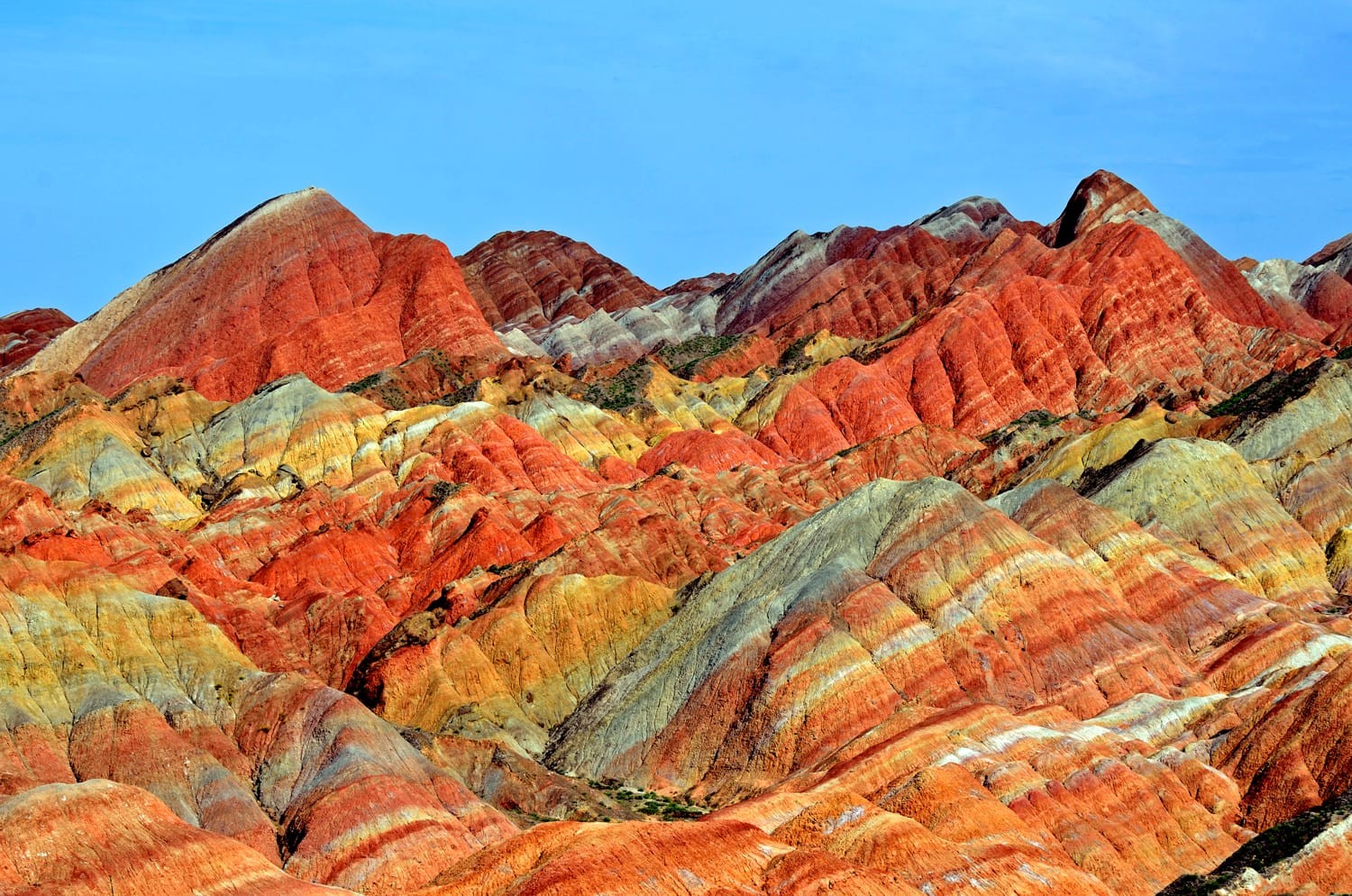
63. Old Walled City of Shibam, Yemen:
The Old Walled City of Shibam is a UNESCO World Heritage Site located in the Hadhramaut Governorate of Yemen. It is known as the oldest and best-preserved example of a traditional walled city in the world. The city is made up of over 500 mud-brick tower houses, some of which are up to 11 stories high. The city is surrounded by a fortified wall, which was built in the 16th century to protect the city from invaders.
The city is also home to a number of mosques, including the Great Mosque of Shibam, which dates back to the 16th century. The city is a popular tourist destination and is known for its unique architecture and stunning views of the surrounding desert landscape.
64. Mostar, Bosnia & Herzegovina:
Mostar is a city in Bosnia and Herzegovina, located on the Neretva River. It is the fifth-largest city in the country and the administrative center of Herzegovina-Neretva Canton. Mostar is known for its iconic Old Bridge, which was built in the 16th century and is a symbol of the city. The city is also home to a number of other historic sites, including the Koski Mehmed-Pasha Mosque, the Karadoz-Beg Mosque, and the Stari Most (Old Bridge) Museum. The city is also known for its vibrant nightlife, with a number of bars, clubs, and restaurants.
65. Meteora, Greece:
Meteora is a rock formation in central Greece, located near the town of Kalambaka. It is home to one of the largest and most important complexes of Eastern Orthodox monasteries in Greece, second only to Mount Athos. The monasteries are built on natural sandstone rock pillars, at the northwestern edge of the Plain of Thessaly near the Pineios river and Pindus Mountains. The six monasteries are built on immense natural pillars and hill-like rounded boulders that dominate the local area. It is included on the UNESCO World Heritage List.
66. Dorset and East Devon Coast, UK:
The Dorset and East Devon Coast is a World Heritage Site in the United Kingdom. It is a stunning stretch of coastline that stretches from Exmouth in East Devon to Old Harry Rocks in Dorset. The area is known for its stunning natural beauty, with dramatic cliffs, sandy beaches, and picturesque villages. It is also home to a variety of wildlife, including seabirds, dolphins, and seals. The area is popular with tourists, who come to enjoy the stunning scenery, take part in water sports, and explore the many attractions.
67. Historic Centre of Bukhara, Uzbekistan:
The Historic Centre of Bukhara is a UNESCO World Heritage Site located in the city of Bukhara, Uzbekistan. The site includes a number of monuments, including the Ark of Bukhara, the Lyabi-Khauz Complex, the Poi-Kalyan Complex, the Chor-Minor Madrasah, the Magoki-Attori Mosque, the Kalyan Minaret, and the Bolo-Khauz Mosque. The site is a testament to the city's long and rich history, which dates back to the 4th century BC. The monuments are a mix of Islamic, Persian, and Central Asian architectural styles, and are a reminder of the city's importance as a major trading hub on the Silk Road.
68. Białowieża Forest, Poland/Belarus:
Białowieża Forest is a UNESCO World Heritage Site located on the border of Poland and Belarus. It is one of the last and largest remaining parts of the immense primeval forest that once stretched across the European Plain. The forest is home to a wide variety of wildlife, including the European bison, the continent’s largest land mammal. It is also home to a number of rare and endangered species, such as the Eurasian lynx, the European otter, and the lesser spotted eagle. The forest is also a popular destination for birdwatchers, as it is home to over 250 species of birds. The forest is also a popular destination for hikers, with a number of trails and paths winding through the forest.
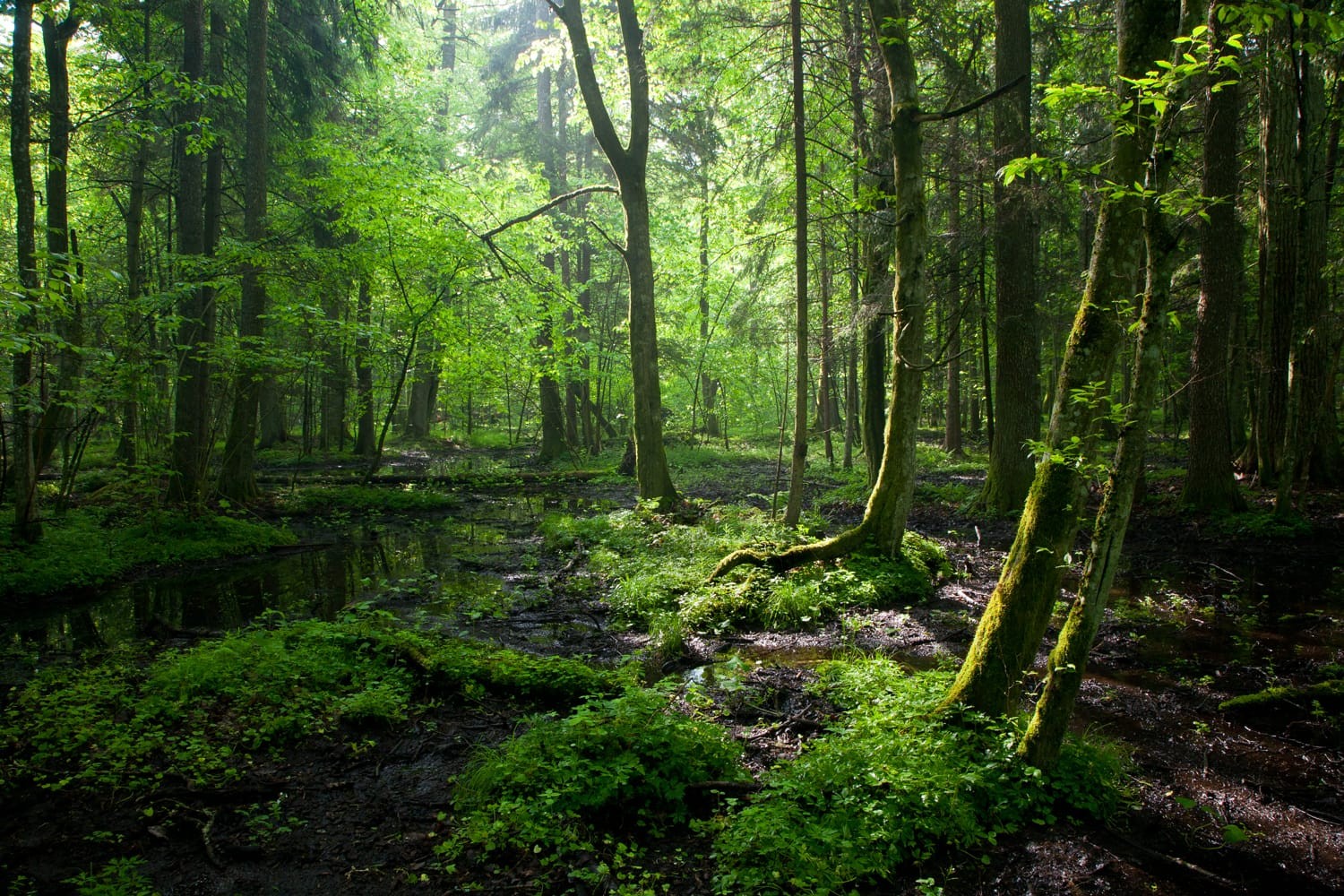
69. Lut Desert, Iran:
The Lut Desert is a large salt desert located in the eastern part of Iran. It is one of the world's driest and hottest places, with temperatures reaching up to 70°C (158°F) in the summer. The desert covers an area of about 51,800 square kilometers (20,000 square miles) and is home to a variety of wildlife, including gazelles, foxes, and lizards. The desert is also home to a number of archaeological sites, including the ancient city of Shahr-e Sukhteh, which dates back to the Bronze Age. The Lut Desert is a popular destination for tourists, who come to experience its unique landscape and wildlife.
70. Mount Etna, Italy:
Mount Etna is an active stratovolcano on the east coast of Sicily, Italy. It is the highest active volcano in Europe and one of the most active in the world. It is also one of the most studied volcanoes, with its eruptions documented since 1500 BC. Etna is known for its frequent and sometimes violent eruptions, which have caused much destruction over the centuries. Its eruptions can be explosive, effusive, or both, and can produce lava flows, ash, and other volcanic debris.
71. Geirangerfjord and Nærøyfjord, Norway:
Geirangerfjord and Nærøyfjord are two of Norway's most spectacular fjords. Located in the western part of the country, they are part of the UNESCO World Heritage Site of the West Norwegian Fjords. Geirangerfjord is known for its dramatic scenery, with its towering cliffs, lush vegetation, and numerous waterfalls. Nærøyfjord is the narrowest fjord in Europe, and is surrounded by steep mountains and lush valleys. Both fjords offer stunning views and a variety of activities, such as kayaking, hiking, and sightseeing.
72. Agra Fort, India:
Agra Fort is a 16th-century Mughal fort located in Agra, India. It was built by the Mughal emperor Akbar in 1565 and is one of the most important monuments in India. The fort is a UNESCO World Heritage Site and is considered to be one of the most important forts in India. The fort is made of red sandstone and is surrounded by a moat. Inside the fort, there are several palaces, mosques, and other structures. The fort also has a number of gates, including the Delhi Gate, the Amar Singh Gate, and the Lahore Gate. The fort is a popular tourist destination and is visited by thousands of people every year.
73. Silk Roads, China/Kazakhstan/Kyrgyzstan:
The Silk Roads were a network of trade routes that connected China, Kazakhstan, and Kyrgyzstan. These routes allowed merchants to transport goods, such as silk, spices, and other luxury items, from one region to another. The Silk Roads also served as a cultural exchange, allowing ideas, religions, and technologies to spread throughout the region. The Silk Roads were an important part of the development of the region, and their influence can still be seen today.
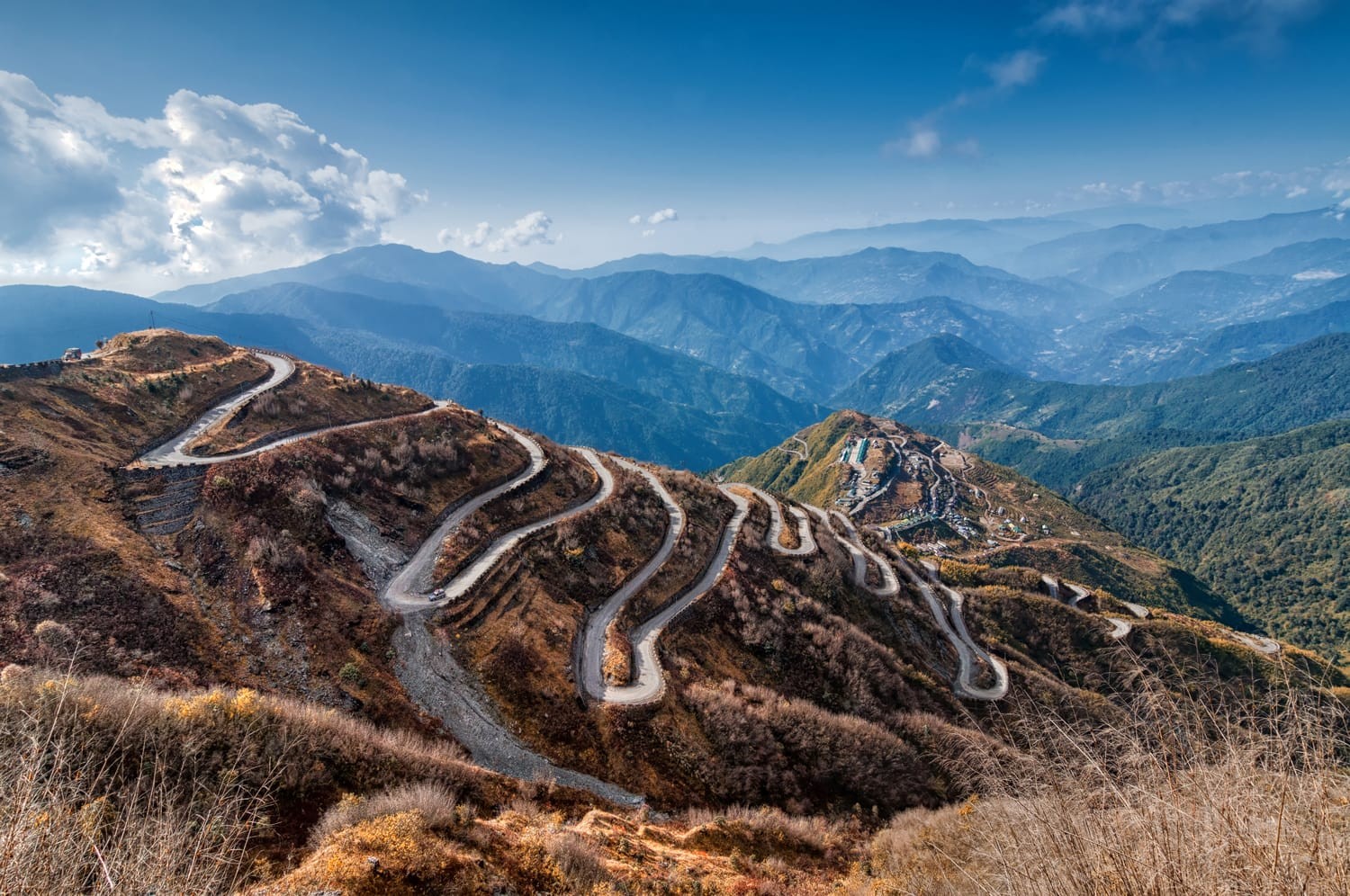
74. Delphi, Greece:
Delphi is an ancient Greek city located in the region of Phocis, on the slopes of Mount Parnassus. It was the site of the famous Oracle of Apollo, and was considered to be the center of the world by the ancient Greeks. Delphi was also home to the Pythian Games, a religious and athletic festival held every four years. Today, Delphi is a popular tourist destination, with many ancient ruins and monuments still standing.
75. Antigua Guatemala, Guatemala:
Antigua Guatemala es una ciudad colonial ubicada en el departamento de Sacatepéquez, Guatemala. Esta ciudad fue la capital de Guatemala desde 1543 hasta 1773, cuando fue destruida por un terremoto. Desde entonces, Antigua Guatemala se ha convertido en un destino turístico popular, conocido por sus edificios coloniales, sus calles adoquinadas y sus numerosos mercados. La ciudad también es famosa por sus fiestas religiosas y sus festivales anuales, como el Carnaval de Antigua Guatemala. La ciudad también es un importante centro cultural, con numerosos museos, galerías de arte y teatros.
77. Neuschwanstein Castle, Germany:
Neuschwanstein Castle is a 19th-century Romanesque Revival palace on a rugged hill above the village of Hohenschwangau near Füssen in southwest Bavaria, Germany. The palace was commissioned by Ludwig II of Bavaria as a retreat and as an homage to Richard Wagner. It was opened to the public shortly after his death in 1886. Since then more than 61 million people have visited the castle. Neuschwanstein embodies both the contemporaneous architectural fashion of the Romanticism period and Ludwig's personal tastes as a devoted admirer of the operas of Richard Wagner. The palace has appeared prominently in several movies and was the inspiration for Disneyland's Sleeping Beauty Castle and later, similar structures.
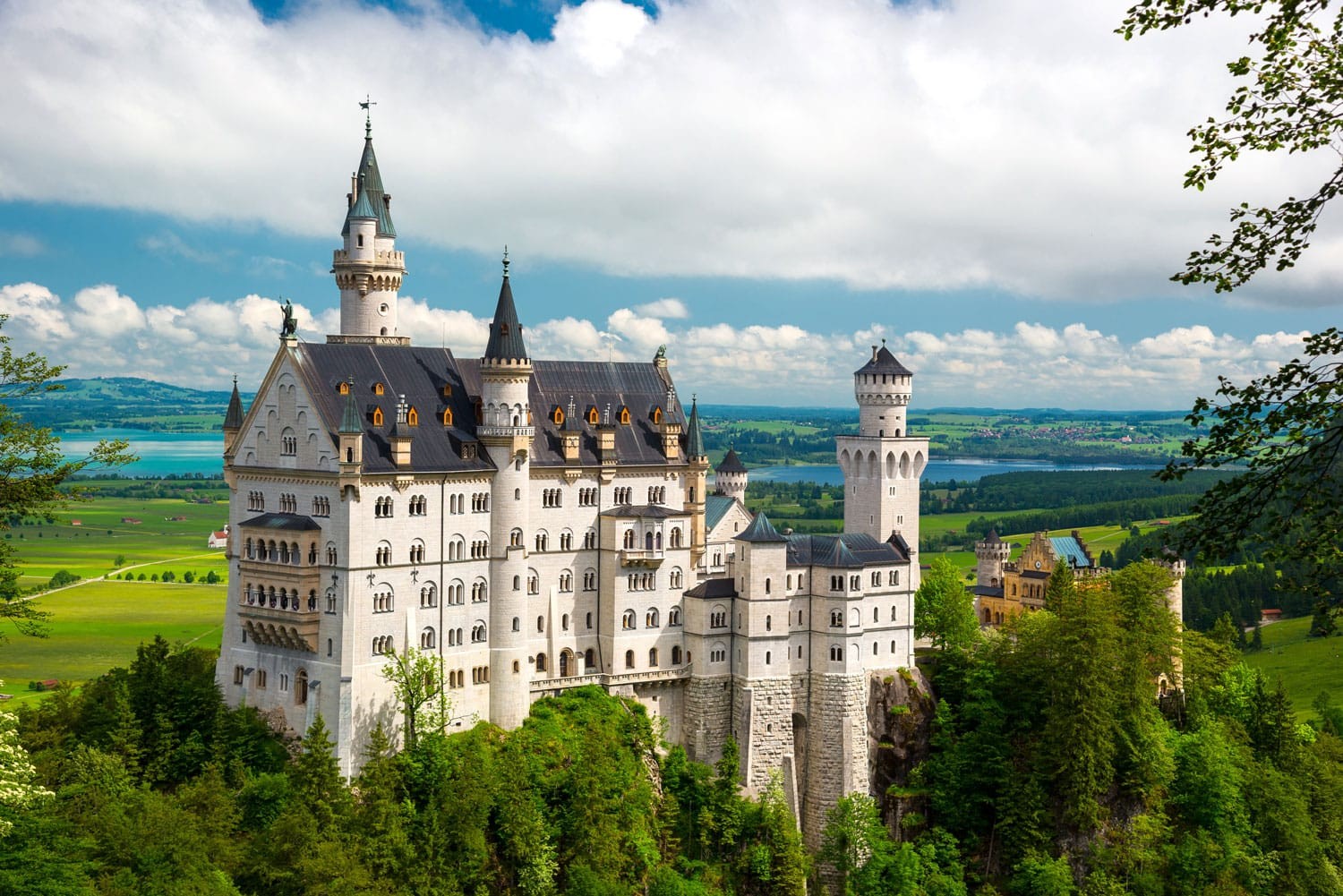
78. Budapest, Hungary:
Budapest is the capital and largest city of Hungary. It is one of the most beautiful cities in Europe and is known for its stunning architecture, vibrant culture, and rich history. The city is home to many attractions, including the iconic Chain Bridge, the Buda Castle, the Hungarian Parliament Building, and the Széchenyi Thermal Bath. Budapest is also a great destination for foodies, with a wide variety of restaurants, cafes, and bars. The city is also known for its nightlife, with many clubs and bars to explore.
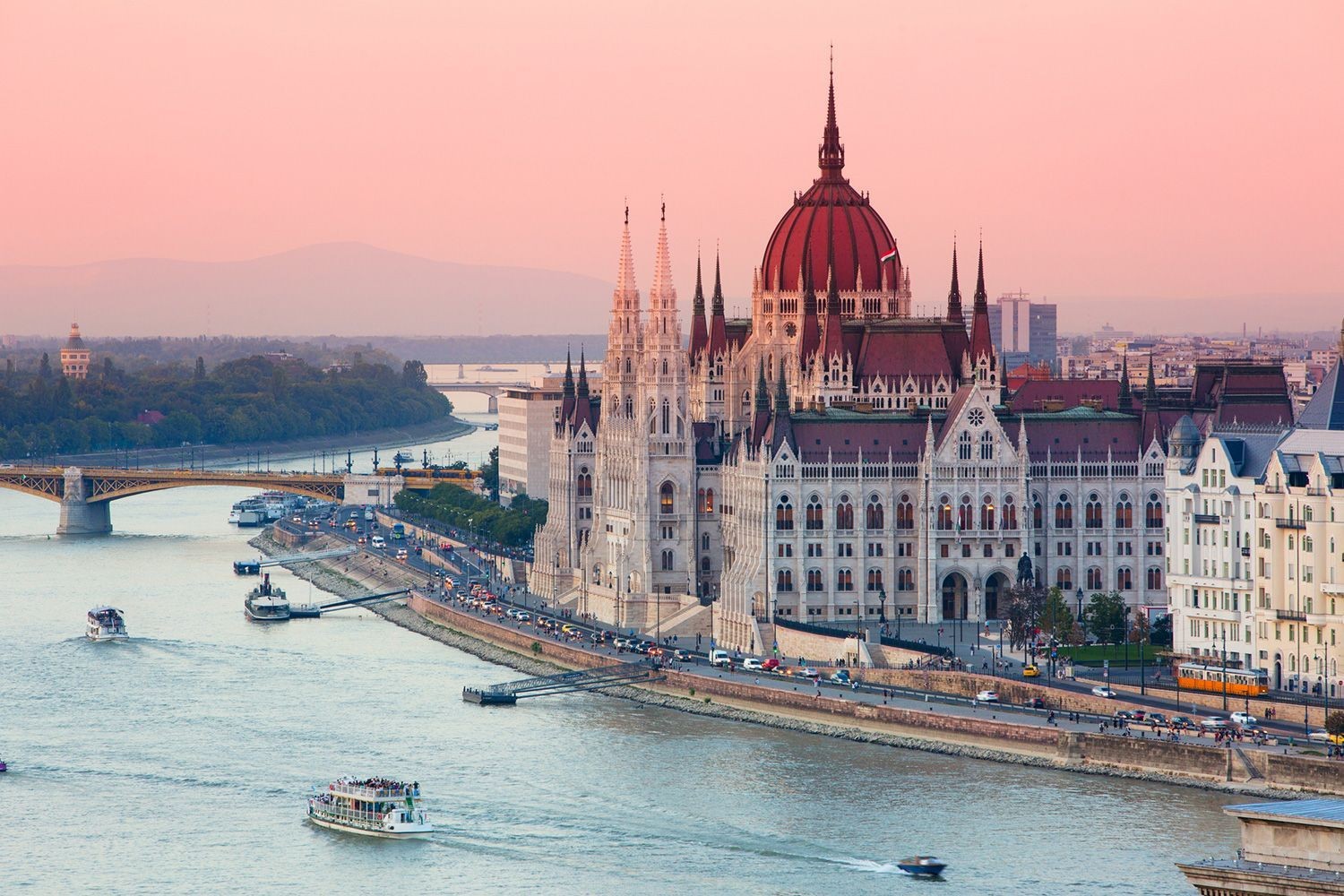
79. Historic Centre of Prague, Czech Republic:
The Historic Centre of Prague is a UNESCO World Heritage Site located in the Czech Republic. It is a well-preserved complex of monuments, churches, palaces, and other buildings that date back to the Middle Ages. The area is home to some of the most iconic landmarks in the city, including the Charles Bridge, Prague Castle, Old Town Square, and the Jewish Quarter. The area is also home to a number of museums, galleries, and other cultural attractions. Visitors to the area can explore the winding cobblestone streets, take in the stunning architecture, and enjoy the vibrant atmosphere of the city.
80. Saint Petersburg, Russia:
Saint Petersburg is the second largest city in Russia and the country's cultural capital. It is located on the Neva River at the head of the Gulf of Finland on the Baltic Sea. The city is known for its grand architecture, including the Winter Palace, the Peter and Paul Fortress, the Mariinsky Theatre, the Hermitage Museum, and the Church of the Savior on Spilled Blood. It is also home to many parks, gardens, and canals, as well as numerous bridges, monuments, and statues. The city is a popular tourist destination, with a wide range of attractions, activities, and events.
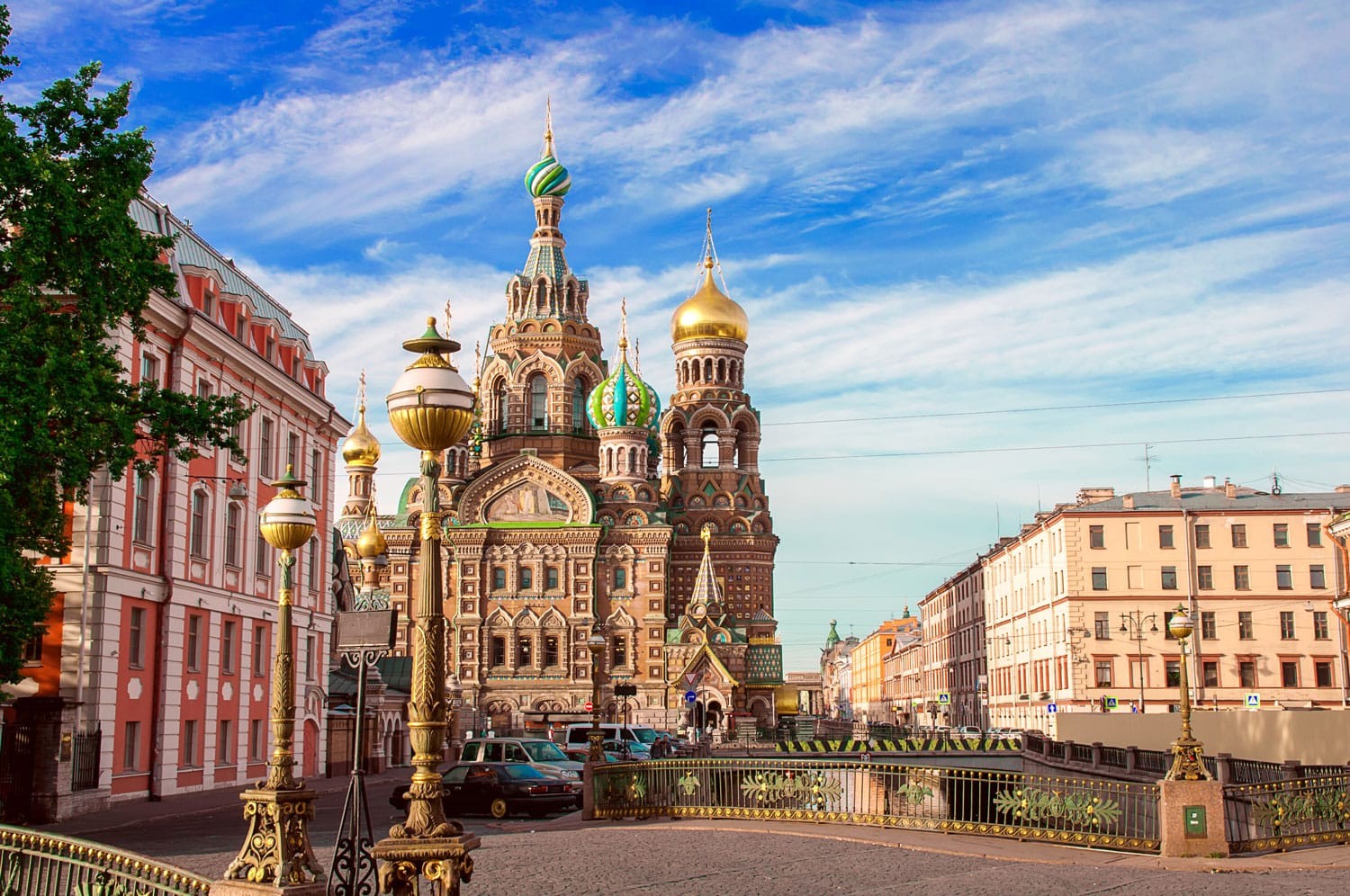
81. Hoi An Ancient Town, Vietnam:
Hoi An Ancient Town is a well-preserved example of a Southeast Asian trading port dating from the 15th to the 19th century. Located in central Vietnam, the town is a UNESCO World Heritage Site and is known for its well-preserved architecture, traditional crafts, and vibrant atmosphere. The town is filled with colorful buildings, narrow streets, and a mix of Chinese, Japanese, and Vietnamese influences. Visitors can explore the old town, visit the many temples, and take part in the vibrant nightlife. There are also plenty of shops, restaurants, and cafes to explore. Hoi An is a great place to experience traditional Vietnamese culture and to learn about the country’s history.
82. Rio de Janeiro, Brazil:
Rio de Janeiro is the second largest city in Brazil and the capital of the state of Rio de Janeiro. It is known for its stunning beaches, vibrant culture, and stunning natural beauty. The city is home to iconic landmarks such as the Christ the Redeemer statue, Sugarloaf Mountain, and Copacabana Beach. It is also a major cultural center, with a thriving music and art scene. Rio de Janeiro is a popular tourist destination, with visitors coming from all over the world to experience its unique atmosphere.
83. Palace and Park of Versailles, France:
The Palace of Versailles is a royal château in Versailles, in the Île-de-France region of France. It was built by Louis XIV, the Sun King, between 1661 and 1710 as a symbol of his power and grandeur. The palace is now a UNESCO World Heritage Site and is one of the most visited tourist attractions in France.
The Palace of Versailles is surrounded by the magnificent Versailles Park, which covers more than 800 hectares and includes a variety of gardens, fountains, and sculptures. The gardens are divided into the French Garden, the English Garden, and the Grand Trianon. The gardens are filled with a variety of flowers, trees, and shrubs, and are a popular spot for visitors to take a stroll and admire the beauty of the palace and its surroundings. The park also includes the Grand Canal, which is a large artificial lake that was built by Louis XIV.
The Palace of Versailles is a must-see for anyone visiting France. It is a symbol of the power and grandeur of the French monarchy and a reminder of the country’s rich history and culture.
84. Stonehenge, UK:
Stonehenge is a prehistoric monument located in Wiltshire, England. It is composed of a ring of standing stones, each around 13 feet (4.0 m) high, 7 feet (2.1 m) wide and weighing around 25 tons. The stones are set within earthworks in the middle of the most dense complex of Neolithic and Bronze Age monuments in England, including several hundred burial mounds. Archaeologists believe it was built anywhere from 3000 BC to 2000 BC. Its purpose is still debated to this day, with theories ranging from religious or ceremonial purposes to astronomical alignments.
85. Historic Centre of Tallinn, Estonia:
The Historic Centre of Tallinn is a UNESCO World Heritage Site located in the capital of Estonia. It is a well-preserved medieval city with cobblestone streets, old churches, and a variety of architectural styles. The city is home to many museums, galleries, and other cultural attractions. The city is also known for its vibrant nightlife and lively festivals. The Historic Centre of Tallinn is a great place to explore the history and culture of Estonia.
86. Ancient Kyoto, Japan:
Kyoto was the capital of Japan from 794 to 1868 and is known for its rich cultural heritage. During the Heian period (794-1185), the city was the center of Japanese culture and politics. It was home to the Imperial Court and the residence of the Emperor. Kyoto was also the birthplace of many of Japan's most important cultural and religious traditions, including Buddhism, Shintoism, and the tea ceremony. The city was also home to many of Japan's most famous temples, shrines, and gardens, including the Golden Pavilion, Kiyomizu-dera, and the Imperial Palace. Kyoto was also the site of many important battles during the Sengoku period (1467-1573). Today, Kyoto is a popular tourist destination, with many of its historic sites and temples still intact.
87. Bryggen, Norway:
Bryggen is a UNESCO World Heritage Site located in Bergen, Norway. It is a collection of Hanseatic commercial buildings that were built in the 14th century. The buildings are made of wood and are painted in the traditional colors of red, yellow, and white. The area is a popular tourist destination and is home to many restaurants, shops, and museums. It is also a popular spot for fishing and sailing.
88. Mount Fuji, Japan:
Mount Fuji is the highest mountain in Japan and one of the country's most iconic landmarks. Located on the island of Honshu, it is an active stratovolcano that last erupted in 1707–1708. It stands at 3,776 meters (12,389 feet) tall and is the second-highest peak in Japan after Mount Kita. Mount Fuji is a popular destination for hikers and climbers, and its symmetrical cone shape is a symbol of Japan and its culture. It is also a UNESCO World Heritage Site and is featured in many works of art.
89. Historic Centre of Bruges, Belgium:
The Historic Centre of Bruges, Belgium is a UNESCO World Heritage Site located in the city of Bruges, in the Flemish Region of Belgium. The site includes the city's medieval core, which is one of the best-preserved in Europe, and is a testament to the wealth and power of the city in the Middle Ages. The Historic Centre of Bruges is home to a number of important monuments, including the Belfry of Bruges, the Church of Our Lady, and the Market Square. The city is also known for its canals, which are lined with picturesque buildings and cobbled streets. The Historic Centre of Bruges is a popular tourist destination, and is a great place to explore the city's history and culture.
90. Kremlin and Red Square, Moscow, Russia:
The Kremlin and Red Square are two of the most iconic landmarks in Moscow, Russia. The Kremlin is a fortified complex that has served as the official residence of the Russian president since the 15th century. It is also home to several museums, churches, and other important buildings. Red Square is a large public square located in the center of Moscow, and it is the site of many important events in Russian history. It is also home to the iconic St. Basil's Cathedral, the State Historical Museum, and the Lenin Mausoleum.
91. Loire Valley, France:
The Loire Valley in France is a stunning region of rolling hills, lush vineyards, and picturesque villages. It is known for its many châteaux, or castles, which were built by the French nobility in the 15th and 16th centuries. The Loire Valley is also home to some of the country’s best wines, including Sancerre, Pouilly-Fumé, and Muscadet. Visitors to the region can explore the many châteaux, sample the local wines, and take in the stunning scenery. The Loire Valley is also a great place to enjoy outdoor activities such as cycling, hiking, and canoeing.
92. Erbil Citadel, Iraq:
Erbil Citadel is an ancient fortress located in the city of Erbil, Iraq. It is believed to be one of the oldest continuously inhabited settlements in the world, with a history stretching back over 7,000 years. The Citadel is situated on a hilltop in the center of the city, and is surrounded by a large wall. Inside the Citadel are a number of historic buildings, including a mosque, a palace, and a number of traditional homes. The Citadel is a popular tourist attraction, and is home to a number of museums and galleries. It is also a UNESCO World Heritage Site.
93. Pantanal, Brazil/Bolivia/Paraguay:
The Pantanal is a vast tropical wetland area located in the heart of South America, spanning across Brazil, Bolivia, and Paraguay. It is the world's largest wetland, covering an area of approximately 140,000 square miles. The Pantanal is home to a wide variety of wildlife, including over 650 species of birds, 300 species of fish, and 80 species of mammals. It is also a popular destination for ecotourism, offering visitors the chance to explore its unique landscape and observe its diverse wildlife.
94. Old and New Towns of Edinburgh, Scotland:
The Old Town of Edinburgh is the oldest part of the city, located on the ridge between the Castle Rock and the Holyrood Park. It is home to the Royal Mile, a cobbled street that runs from the castle to the Palace of Holyroodhouse. The Old Town is also home to many of Edinburgh's most famous attractions, including Edinburgh Castle, St. Giles' Cathedral, and the National Museum of Scotland.
The New Town of Edinburgh was built in the 18th century to relieve overcrowding in the Old Town. It is a planned area of elegant Georgian architecture, with wide streets and grand squares. The New Town is home to many of Edinburgh's most fashionable shops, restaurants, and bars, as well as the National Gallery of Scotland and the Scottish National Portrait Gallery.
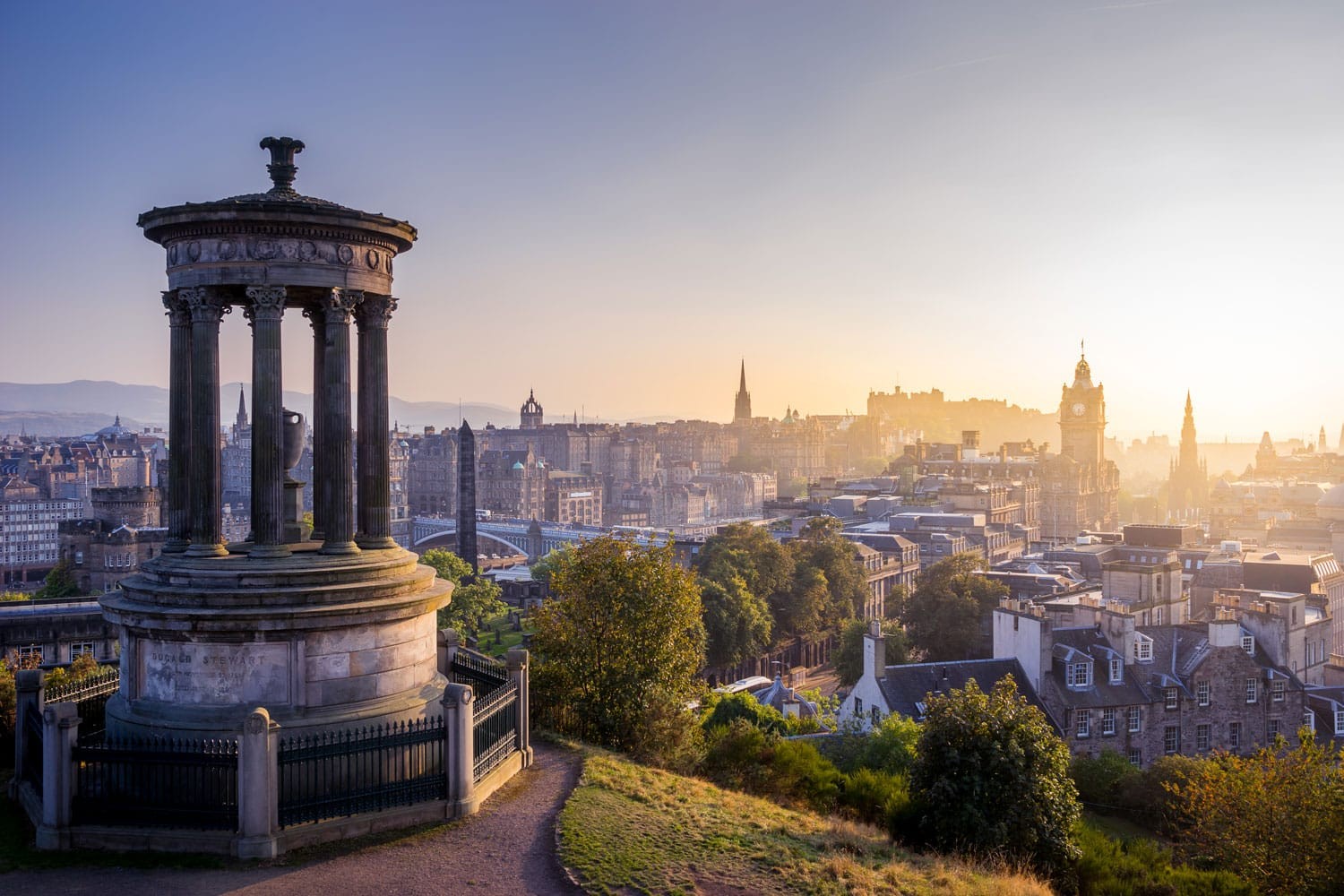
95. Swiss Alps Jungfrau-Aletsch, Switzerland:
The Jungfrau-Aletsch Protected Area is a UNESCO World Heritage Site located in the Swiss Alps. It is the largest glaciated area in the Alps, covering an area of more than 1,000 square kilometers. The area is home to the Jungfrau and Aletsch glaciers, as well as a number of other glaciers, peaks, and valleys. The area is known for its stunning views of the surrounding mountains and glaciers, as well as its diverse wildlife. The area is also popular for its hiking and skiing opportunities.
96. Notre Dame Cathedral, France:
Notre Dame Cathedral is a Gothic cathedral located in Paris, France. It is one of the most famous and iconic landmarks in the world, and is considered to be one of the finest examples of French Gothic architecture. The cathedral was built in the 12th and 13th centuries and is renowned for its stained glass windows, sculptures, and gargoyles. It is also home to many religious artifacts, including the Crown of Thorns and a fragment of the True Cross. Notre Dame is a popular tourist destination, and its interior is open to visitors year-round.
97. Sydney Opera House, Australia:
The Sydney Opera House is an iconic performing arts center located in Sydney, Australia. It is one of the most recognizable buildings in the world and is a UNESCO World Heritage Site. The building was designed by Danish architect Jørn Utzon and opened in 1973. It is home to multiple performing arts companies, including the Sydney Symphony Orchestra, the Sydney Theatre Company, and Opera Australia. The building is also a popular tourist destination, with over 8 million visitors each year. The Sydney Opera House hosts a variety of events, including concerts, theater performances, and other cultural events.
98. Prambanan, Indonesia:
Prambanan is a 9th-century Hindu temple compound in Central Java, Indonesia. It is the largest Hindu temple site in Indonesia and one of the largest in Southeast Asia. The temple is a UNESCO World Heritage Site and is considered to be one of the greatest examples of Hindu architecture. The temple complex consists of eight main shrines, surrounded by hundreds of smaller temples. The main temple is dedicated to the Trimurti, the three main Hindu gods: Brahma, Vishnu, and Shiva. The temple is also known for its intricate carvings and sculptures, which depict scenes from Hindu mythology. Visitors to the temple can explore the complex and learn about the history and culture of the area.
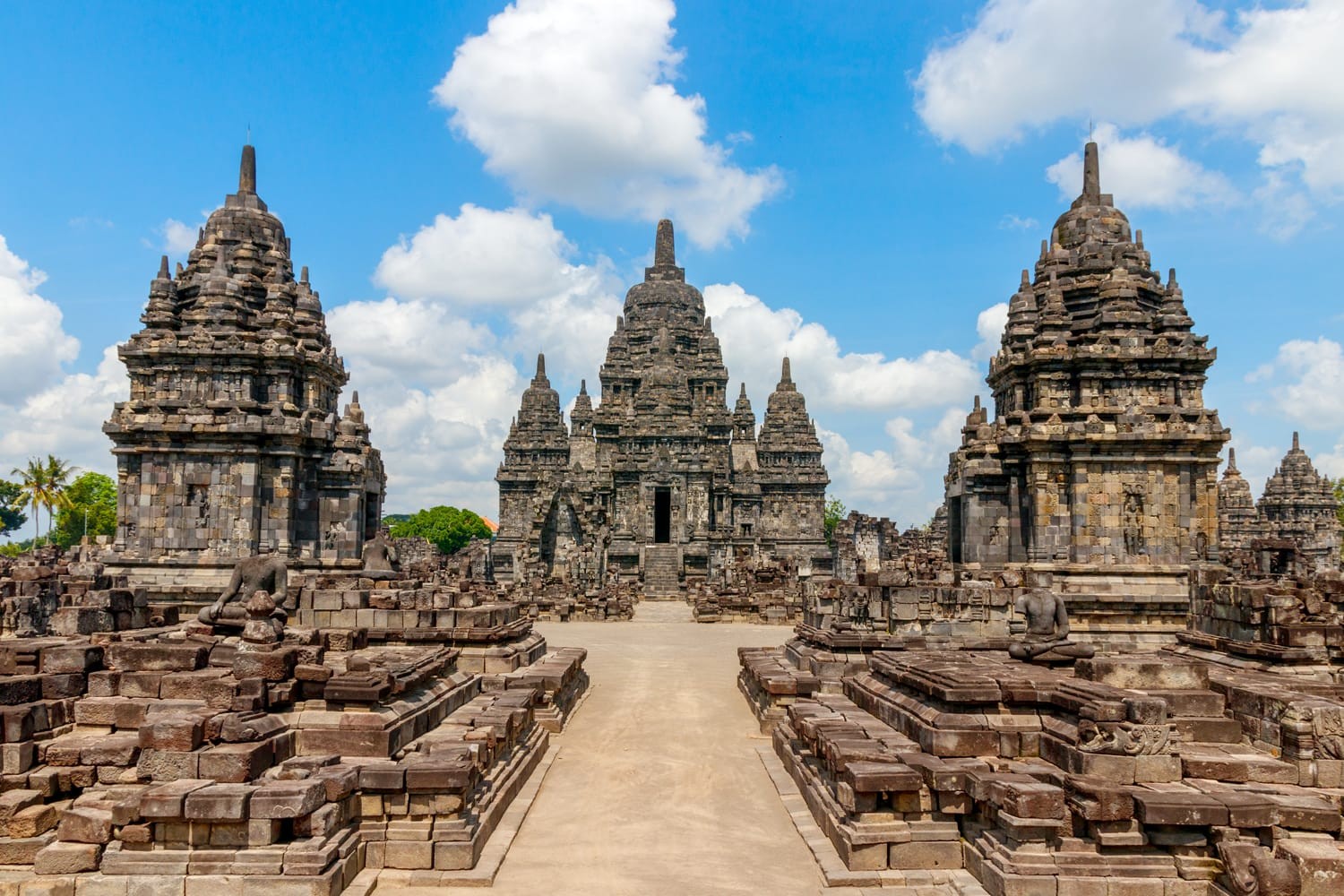
99. Blue Mountains, Australia:
The Blue Mountains are a mountainous region in New South Wales, Australia. The region is home to a range of attractions, including the Three Sisters rock formation, the Jenolan Caves, and the Katoomba Scenic Railway. The area is also known for its stunning views, bushwalking trails, and waterfalls. The Blue Mountains are a popular destination for tourists, with many visitors coming to explore the area's natural beauty.
100. Valletta, Malta:
Valletta is the capital city of Malta, located on the island's east coast. It is a UNESCO World Heritage Site and is known for its Baroque architecture, narrow streets, and fortifications. Valletta is home to many historical sites, including the Grand Master's Palace, St. John's Co-Cathedral, and the Upper Barrakka Gardens. The city is also a popular destination for shopping, dining, and nightlife.
The 100 Most Famous & Beautiful UNESCO World Heritage Sites encapsulate the extraordinary wonders of our planet. These sites serve as testaments to human ingenuity, cultural significance, and the need for environmental preservation. They offer a glimpse into the richness of our shared history and the remarkable diversity of our natural landscapes. From the grandeur of architectural masterpieces to the untouched beauty of natural habitats, these sites inspire awe and ignite a sense of appreciation for the world we inhabit. They remind us of the responsibility we bear to protect and cherish our heritage for future generations. As we explore these exceptional destinations, let us continue to celebrate and safeguard these invaluable treasures, ensuring that they endure as lasting symbols of human achievement and the immense beauty that surrounds us.




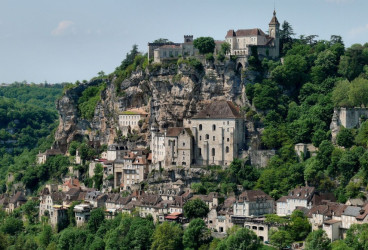







{{item.get_author.first_name}} {{item.get_author.last_name}}
Level 7
5 Photos
36 Reviews
{{item.comment_txt}}
{{item_reply.get_author.first_name}} {{item_reply.get_author.last_name}}
@ {{item_reply.reply_to}}, {{item_reply.reply_txt}}